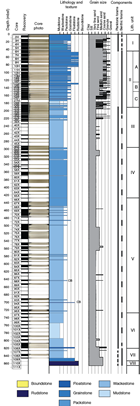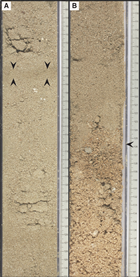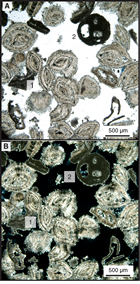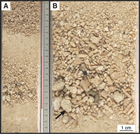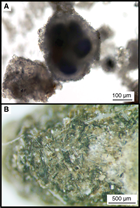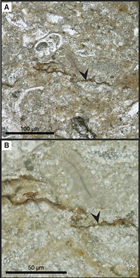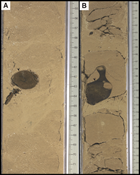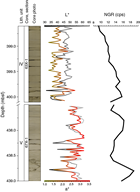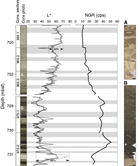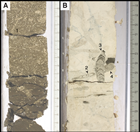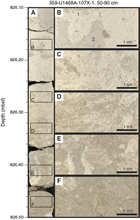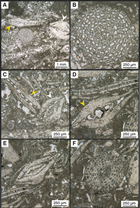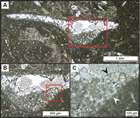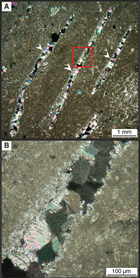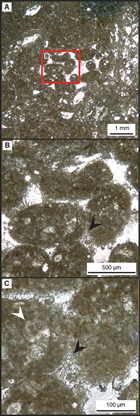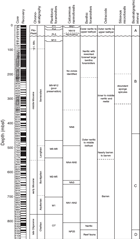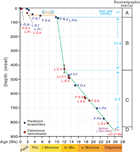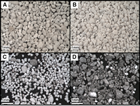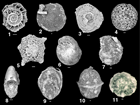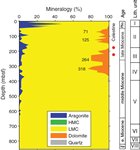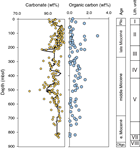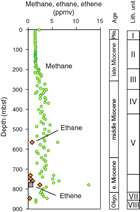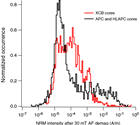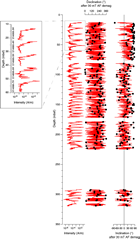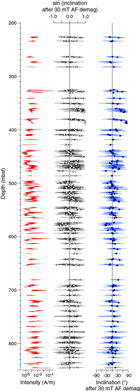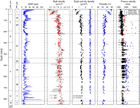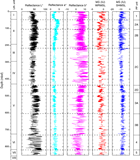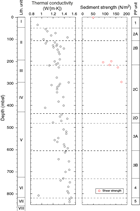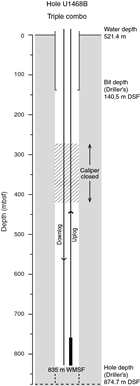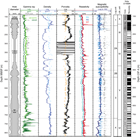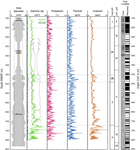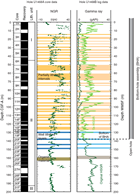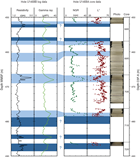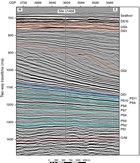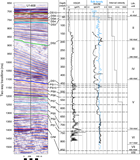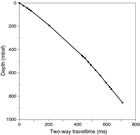Betzler, C., Eberli, G.P., Alvarez Zarikian, C.A., and the Expedition 359 Scientists
Proceedings of the International Ocean Discovery Program Volume 359
publications.iodp.org
doi:10.14379/iodp.proc.359.106.2017
Site U14681
C. Betzler, G.P. Eberli, C.A. Alvarez Zarikian, M. Alonso-García, O.M. Bialik, C.L. Blättler, J.A. Guo, S. Haffen, S. Horozal, M. Inoue, L. Jovane, D. Kroon, L. Lanci, J.C. Laya, A. Ling Hui Mee, T. Lüdmann, M. Nakakuni, B.N. Nath, K. Niino, L.M. Petruny, S.D. Pratiwi, J.J.G. Reijmer, J. Reolid, A.L. Slagle, C.R. Sloss, X. Su, P.K. Swart, J.D. Wright, Z. Yao, and J.R. Young2
Keywords: International Ocean Discovery Program, IODP, JOIDES Resolution, Expedition 359, Site U1468, Maldives, Kardiva Channel, Goidhoo atoll, Indian Ocean paleoceanography, Oligocene, Miocene, Pliocene, Pleistocene, carbonate platform, carbonate platform drowning, celestine, dolomite, drift deposits, large benthic foraminifers, monsoon, sea level, sequence stratigraphy
MS 359-106: Published 4 May 2017
Background and objectives
Site U1468 (proposed Site MAL-03A) is at the eastern end of the northern transect drilled in the Inner Sea of the Maldives during International Ocean Discovery Program (IODP) Expedition 359. It is located at 4°55.98′N and 73°4.28′E (Figure F1) at a water depth of 521.5 m, 4.8 km east of Site U1466. The site lies in the western part of the Kardiva Channel, which connects the Inner Sea of the Maldives with the Indian Ocean. Site U1468 is located approximately 6.4 km east of the edge of the youngest growth packages of the Kardiva platform, which is capped by a drowning unconformity (see Figure F2 in the Site U1465 chapter [Betzler et al, 2017c]). It was chosen for three reasons. First, seismic horizon O/M (Belopolsky and Droxler, 2004), which was predicted to represent the Oligocene/Miocene boundary (Betzler et al., 2013a), is at the shallowest position in the coring area at this location. The target depth was placed below this horizon to retrieve the sedimentary record from the upper Oligocene into the lowest Miocene succession of the shallow Inner Sea. Second, Site U1468 cores contain the complete Miocene evolution of the Kardiva platform from its distal slope deposits. During the early Miocene, the marginal platforms, such as the Kardiva platform, aggraded. They then prograded in the middle Miocene and ultimately drowned. The position of Site U1468 on slightly inclined seismic lines of the distal slope records the timing of platform progradation and drowning in a basinal position. Site U1468 cores therefore have the potential to retrieve a hemipelagic sequence of sediments containing planktonic foraminifers and calcareous nannoplankton suitable for biostratigraphic analysis. Third, platform-related sediments at Site U1468 are overlain by a 426 ms two-way traveltime (TWT) thick succession of current-controlled deposits that allows for dating the age of the onset of drift related to the onset of the Indian monsoon. Drift sequence (DS) DS1 is most expanded at this location, with DS2 reduced in thickness and capped by amalgamated DS3–DS8 (Figure F49).
The objectives at this site were (1) to analyze the cyclostratigraphy of drift deposits, therefore providing reconstructions of changes in the current regime and monsoon cyclicity; (2) to provide a detailed reconstruction of the predrowning, drowning, and postdrowning evolution of the carbonate bank by linking the seismic stratigraphic record to the sedimentary record; (3) to constrain the timing of this evolution, thus allowing age assignments of unconformities, sedimentary interruptions, sedimentary turnovers, and onset of drift deposition; and (4) to reconstruct and date bank to drift turnover. In view of the coring results at Sites U1466 and U1467, permission was requested to deepen the hole from 532 to 1000 meters below seafloor (mbsf). With this approved request, we wanted to reach the Oligocene/Miocene boundary and to acquire cores to reconstruct environmental changes into and throughout the Neogene.
Based on the age model from Belopolsky and Droxler (2004), the base of the drift sequences is in the middle Miocene, which was verified at Site U1466. With coring at a more distal position within the drift, refinement of the onset of current-dominated deposition was expected. Likewise, the ages of the sea level–controlled platform sequences that are conformable seismic reflections below the drift sequences are embedded within the datable succession. The target was seismic horizon O/M, which was defined by Belopolsky and Droxler (2004) and traced into the northern transect by Betzler et al. (2013a, 2013b).
Operations
Transit to Site U1468
The 13.6 nmi transit from Site U1467 to Site U1468 required only 1.5 h, and by 0232 h on 7 November 2015, the ship arrived over the site coordinates and switched to the dynamic positioning system. Soon after, the rig crew began assembling the advanced piston corer (APC)/extended core barrel (XCB) bottom-hole assembly (BHA). A positioning beacon was deployed, and the drill string was lowered to the seafloor.
Hole U1468A
For Site U1468, we obtained an extension from the Environmental Protection and Safety Panel to extend the total approved penetration depth to 1000 mbsf to ensure the achievement of the site’s main scientific objective of coring thorough the Oligocene/Miocene boundary. Ultimately, coring with the XCB system terminated with Core 359-U1468A-111X at a total depth of 874.7 mbsf when the biostratigraphers confirmed the Oligocene age of the recovered core (see Figure F1 in the Expedition 359 summary chapter [Betzler et al, 2017b]).
Hole U1468A was spudded at 0830 h on 7 November 2015, establishing a seafloor depth of 521.5 m. Nonoriented APC coring continued through Core 13H to 112.6 mbsf. Coring using the half-length APC (HLAPC) followed until APC refusal on Core 38F at 225.6 mbsf. Coring with the XCB coring system continued. Hole stability was maintained throughout by circulating 20 bbl high-viscosity mud sweeps every other core. This process resulted in little or no fill on connections, normal drilling torque, and no overpull or drag with the drill string. After laying out the final core barrel, the bit was raised to 795.5 mbsf and the top drive was set back. The drill string was pulled out of the hole, clearing the seafloor at 2215 h, and the bit arrived on the rig floor at 2400 h on 11 November. Total core recovered in Hole U1468A was 458.7 m (53%). Of the 110 cores recovered, 14 were APC cores, 31 were HLAPC cores, and 65 were XCB cores (Table T1).
Table T1. Site U1468 core summary. Download table in .csv format. View PDF table.
Hole U1468B
We offset the ship 20 m east of Hole U1468A and started assembling the tricone drill bit with a mechanical bit release to drill the dedicated logging hole. An extra stand of 8¼ inch drill collars was added to the existing drilling BHA to place the bit at ~130 mbsf or slightly deeper to allow the end of the pipe to extend below a potentially problematic sand package. We lowered the bit to the seafloor and started drilling without coring in Hole U1468B at 0810 h on 12 November 2015. During the course of drilling the dedicated logging hole, the driller noted elevated drilling torque and hole cleaning problems at 131.7 mbsf. At 1345 h, we spent nearly 2 h conducting a wiper trip by raising the bit to 43.5 mbsf and then running it back to the bottom of the hole. At 1530 h, drilling resumed and continued without incident until the bit reached a total depth of 874.7 mbsf at 2030 h on 12 November. We circulated a high-viscosity mud sweep, released the bit in the bottom of the hole, and at 0115 h on 13 November the end of the pipe had been positioned at 140.5 mbsf in preparation for wireline logging. We rigged up the triple combo tool string and ran it into Hole U1468B at 0240 h. The tool string reached ~835 mbsf, where it tagged bottom, indicating ~40 m of infill in the hole. A short pass logged from the bottom of the hole up to ~735 mbsf showed reasonable hole diameter. The tool string was run back to total depth, and the main pass started at 835 mbsf, recording gamma radiation, density, porosity, electrical resistivity, and magnetic susceptibility. Borehole diameter varied smoothly, ranging from ~17 to 12 inches, until a narrow section (<6 inches) was encountered at ~465 mbsf. Significant overpull was required to continue pulling the tool string up to ~290 mbsf, suggesting the borehole had deteriorated in this interval. Above ~290 mbsf, hole diameter increased, and the main pass continued up to the base of the drill pipe at 140 mbsf. Logging data were recorded continually throughout the main pass with the triple combo tool string, but further logging operations could not be carried out because of the state of the borehole. The tool string was returned to the rig floor and rigged down, and logging operations in Hole U1468B were completed by 0915 h on 13 November. After rigging down from wireline logging, the pipe was pulled out of the hole, clearing the seafloor at 0935 h. Hole U1468B ended when the bit arrived back on the rig floor at 1125 h.
Lithostratigraphy
Site U1468 was drilled through a series of drift deposits into the distal bottomsets of the Miocene Kardiva platform and bottomed out in an Oligocene shallow-water platform, as shown on seismic profiles (Figure F2). The scientific objectives at this site were to analyze the cyclostratigraphy of drift deposits by providing reconstructions of changes in the current regime and monsoon cyclicity and to constrain the timing of unconformities and sedimentary interruptions. One hole was cored at this site, and eight lithostratigraphic units were identified (Figure F3). The drift package at Site U1468 comprises Units I–IV, and the distal slope of the Miocene Kardiva platform consists of Unit V. Lithologies of a restricted basin environment define Unit VI, and those of a shallow-water basin environment are grouped into Unit VII. The last unit, Unit VIII, is the Oligocene shallow-water platform.
Lithostratigraphic units
Unit I
Unit I consists of unlithified to partially lithified light brownish gray to light gray and pale yellow/white packstone to grainstone (Figure F4A) and two thin unlithified wackestone intervals no thicker than 55 cm between 17.4–17.95 and 22.72–23.2 mbsf. The main components of Unit I are abundant planktonic foraminifers; benthic foraminifers; pteropods, Halimeda plates, and mollusk fragments; echinoid fragments and spines; otoliths; fish remains; and very rare bryozoans. In general, bioclasts are well preserved. Aggregate grains, organic matter, yellow- to brown-stained lithoclasts, and bioclasts occur throughout the entire unit. The fine fraction contains aragonite needles (<5 µm), calcite crystals (5–10 µm), and calcareous nannofossils (coccoliths). Carbonate texture varies between wackestone, packstone, and grainstone between 17.4 mbsf and the lower unit boundary at 45.67 mbsf, with interbedding thicknesses ranging from centimeters to meters.
Unit II
The boundary between lithostratigraphic Units I and II is placed at the top of an interval with abundant large benthic foraminifers at 45.67 mbsf (Figure F4B). The texture in Unit II varies from grainstone and rudstone at the top of the unit to mudstone and packstone at the base. Bioclasts within this unit are abraded and overgrown with calcite crystals (Figure F5). The 146.79 m thick Unit II contains intercalations of fining- and coarsening-upward intervals that allow the definition of three subunits. Subunit IIA has a coarsening-upward trend from 125.93 to 45.67 mbsf; Subunit IIB coarsens upward from 149.36 to 126.7 mbsf; Subunit IIC fines upward from 192.18 to 178.3 mbsf, followed by a coarsening-upward trend from 178.3 to 150 mbsf. The matrix throughout the entire unit contains abundant calcite crystals and very rare dolomite rhombs and calcareous nannofossils. Throughout this unit, large benthic foraminifers decrease in size downcore from 3 mm at the top to <1 mm at the boundary with Unit III.
Subunit IIA
From 45.67 to 87.78 mbsf, Subunit IIA is dominated by a massive coarse- to granular-grained rudstone succession, occasionally intercalated by thin intervals of fine- to coarse-grained wackestone, packstone, and grainstone that range in thickness from 1 to 50 cm.
The packstone texture is also present as burrow infill, which also contains organic matter. The subunit consists of a granule-grained rudstone for the upper 60 m and is characterized by coarsening-upward fine- to granule-grained large benthic foraminiferal sand within the bottom 20 m. The main components of this unit are large benthic foraminifers (Amphistegina sp., Lepidocyclina sp., Miogypsinoides sp., Heterostegina sp., Operculina sp., and Sphaerogypsina globulus). Echinoid spines, red algae, mollusk fragments, branching and encrusting bryozoans, Halimeda plates, and aggregate grains are also present. A few dolomite rhombs are found in smear slides. Dogtooth, syntaxial overgrowth, and granular calcite cement are present around most of the bioclasts (Figure F6).
Subunit IIB
The major characteristic of Subunit IIB is the cyclic fining-upward successions with sharp basal contacts and grading from fine-grained packstone to medium-grained grainstone between 131.2 and 150 mbsf (Figure F7). The main large benthic foraminifers are S. globulus, Lepidocyclina sp., and Amphistegina sp. Echinoid spines, red algae, mollusk fragments, branching and encrusting bryozoans, and aggregate grains are common. This subunit also marks the start of the downhole size reduction of large benthic foraminifers from interval 23F-1, 0 cm, at 150 mbsf to 192.46 mbsf. Within the matrix, a few dolomite rhombs are observed.
Subunit IIC
Subunit IIC is characterized by two contrasting grain size trends:
- An overall coarsening-upward trend from 150 to 178.5 mbsf that ends with a granular-grained rudstone at the top of the unit, and
- A distinctive overall fining-upward trend from medium- to fine-grained packstone from 178.5 to 190.6 mbsf.
The main components are large benthic foraminifers (S. globulus, Lepidocyclina sp., Amphistegina sp., Operculina sp., Cycloclypeus annulatus, Miogypsinoides sp., and Heterostegina sp.) with common echinoid spines, mollusk fragments, bryozoans, and minor Halimeda plates and red algae. Some bioclasts are coated by a dense micritic crust, probably of microbial origin. Bioclasts locally show fragmentation and contain various cements, including dogtooth and granular calcite that fill intraparticle pore spaces. Dolomite rhombs occur adjacent to calcite crystals. The top of this subunit lacks dolomite rhombs in smear slides, but small amounts are observed at 170.38 mbsf. Dolomite rhombs eventually increase to a common appearance within the matrix at 191.62 mbsf.
Unit III
Unit III is a very fine- to medium-grained wackestone package with two packstone to rudstone intervals up to 5 m thick at 192.46–197.22 and 215.95–216.28 mbsf and two mudstone intervals at 217.7–219.68 and 223.43–223.57 mbsf. Colors include light brownish gray to light gray, pale yellow, and white, irrespective of carbonate texture. In this unit, planktonic foraminifers reappear and large benthic foraminifers are absent. Most bioclasts are heavily overgrown with dogtooth calcite crystals. The matrix contains abundant calcite crystals (Figure F8A). Sponge spicules are rare and appear mostly as aggregate grains and/or intraclasts (Figure F8B). Calcareous nannofossils (coccoliths) are extremely rare to absent (see Biostratigraphy). Dolomite rhombs and aragonite needles occur at different depths within the unit. Dolomite decreases from 199.82 to 233.95 mbsf but increases at 262.72 mbsf to the base of the unit. In contrast, aragonite needles increase from 199.82 to 214.76 mbsf and decrease at 262.72 mbsf to the base of the unit. Organic matter is common, especially in burrow infills.
Unit IV
Unit IV consists of lithified packstone intercalated with three wackestone packages up to 3 m thick (301.1–303.24, 327.45–328.62, and 369.5–370.22 mbsf). The upper unit boundary is marked by a change in degree of lithification into a more competent layer without color or grain size change. Components include bioclasts and planktonic and benthic foraminifers severely overgrown by sparry calcite. Bioclastic components sometimes display oriented flattening and wispy seams resulting from burial compaction (Figure F9). The degree of bioturbation in this unit allows identification of several ichnotaxa, including Thalassinoides, Palaeophycus, Planolites, and Chondrites. Occasionally, chert nodules occur (Figure F10). Smear slide analyses of the fine fraction show an abundance of calcite crystals and dolomite rhombs, common sponge spicules, calcareous nannofossils and glauconite, and few aragonite needles.
Unit V
Unit V is characterized by lithified wackestone intercalated with packstone intervals <2 m thick with large benthic foraminifers, for example, from 427.7 to 448.59 mbsf. Throughout the unit, light and dark intervals alternate. The upper boundary of Unit V is placed at the uppermost white layer observed in the cores (Figure F11). Thirty-eight light-dark couplet intervals were counted. The light portion thickens from less than 1 m to 15 m downhole, whereas the thickness of the dark layers is never more than 5 m. The dark intervals contain abundant organic material and apatite. The color of the dark intervals changes gradationally from light olive-gray at the top of the unit to dark grayish brown at the bottom. The colors of the light intervals range from pale yellow to white throughout the unit, as they lack organic material and contain microcrystalline spar that welds the components together.
The main components in this unit are planktonic foraminifers, benthic foraminifers, and mollusk fragments, and bioclast fragments are common. Most components are overgrown by sparry calcite, and original aragonite tests are no longer preserved. Well-preserved ichnotaxa within this unit include Thalassinoides, Teichichnus, Asterosoma, Phycosiphon, Zoophycos, Palaeophycus, Planolites, and Chondrites. Bioturbation is pervasive, and often several generations of burrowing are observed that are occasionally infilled with glauconite or pyrite crystals. The matrix from smear slide analyses shows an abundance of calcareous nannofossils, aragonite needles, and microcrystalline calcite.
Two completely dolomitized intervals occur in this unit. The first is in Core 72X between 486 and 487.09 mbsf, where the few recovered rocks consist of dolomitized grainstone. Samples from the second interval (Core 77X; 534.6–535.23 mbsf) consist of completely dolomitized wackestone. Two convoluted beds were found in this unit at 88X-1, 0–46 cm (641.3–641.76 mbsf), and 94X-1, 72–106 cm (700.22–700.56 mbsf).
Unit VI
Unit VI consists of lithified wackestone to packstone. The upper unit boundary is placed at a distinctive color change in the darker intervals, from dark grayish brown in Unit V to black in Unit VI at 728.6 mbsf (Figure F12). A total of 41 black-white couplets are found in this unit. Dark intervals range in thickness from 1 to 25 cm. Very fine laminations are visible in well-preserved sections. The dark intervals include abundant organic matter and small ichnotaxa such as Chondrites, Planolites, and Phycosiphon (Figure F13A). Light intervals have a restricted color range from pale gray to white. The light intervals in this subunit are generally less than 2 m thick and contain large ichnotaxa such as Teichichnus, Zoophycos, and Asterosoma (Figure F13B). Occasionally, pyrite and organic matter are present within the burrows (Figure F14A). Planktonic foraminifers are abundant, and benthic foraminifers are present. The matrix contains numerous calcareous nannofossils (Figure F14B) and calcite crystals. Dolomite rhombs are rare.
Unit VII
This unit comprises medium-grained wackestone (Figure F15A–F15C) with coarse- to very coarse grained floatstone intervals that mark the top and bottom of the unit at 817.55–820.4 and 845–847.02 mbsf and a very coarse grained packstone interval in the middle from 825.9 to 827.4 mbsf. The Unit VII boundary marks the reappearance of large benthic foraminifers that are mostly fragmented, sometimes with glauconite precipitate (Figure F14C), and occur with yellow-stained lithoclasts and bioclasts. Floatstone and packstone intervals are usually made up of large benthic foraminifers (Figure F15D–F15F) such as Nummulites sp., Amphistegina sp., Lepidocyclina sp., Cycloclypeus sp., and Miogypsina sp. and occur with planktonic foraminifers and red algae (Figure F16). Skeletal components are held together by a micritic matrix, whereas intraparticle pores are mainly filled with microcrystalline spar. Ichnotaxa include Planolites and Phycosiphon, both of which are usually preserved in very fine to fine-grained wackestone. Some burrows have glauconite and pyrite infill.
Unit VIII
Unit VIII is limestone characterized by the appearance of reef biota. Two different rock textures were observed:
- Fine- to medium-grained light brownish gray rudstone that contains large coral fragments and small and large benthic foraminifers. Small benthic foraminifers are miliolids, and large benthic foraminifers comprise Operculina sp., Amphistegina sp., Heterostegina sp., Lepidocyclina sp., and Alveolina sp.
- Medium-grained pale yellow floatstone consisting of fragmented large benthic foraminifers such as Heterostegina sp. and Amphistegina sp. and common Halimeda plates, bivalve fragments, coral fragments, bryozoan fragments, red algae, echinoid fragments, and echinoid spines in a packstone matrix.
One red algae retained its original hooked structure (Figure F17). Occasionally, pyrite and glauconite are found within the chambers of the foraminifers. Planktonic foraminifers were not observed within the light brownish gray rock from 854.7 to 865 mbsf but are present below 865 mbsf within the pale yellow rock. A few molds have geopetal infill (Figure F18). Other components are preserved as molds or are micritized. Moldic pores are infilled with dogtooth or blocky calcite crystals (Figure F19). Small burrows are filled with pellets cemented with drusy cements (Figure F20).
Discussion
The Site U1468 lithostratigraphy clearly reflects the sedimentological evolution of the Kardiva platform and drift as shown on seismic sections (see Seismic stratigraphy). Unit I represents the youngest of the unconsolidated drift deposits (Lüdmann et al., 2013) and consists of a mixture of pelagic and neritic components and a basinal (background) sediment input dominated by pteropods, otoliths, and planktonic foraminifers. The presence of currents is indicated by the occurrence of yellow- to brown-stained grains from reworking of sediments by bottom currents and by the lack of fine sediments that was removed by currents.
The Unit I/II boundary is defined by a sharp contact (Figure F4) that separates the above-mentioned sediments from Unit II sediments, which consist of large benthic foraminiferal rudstones. Unit II has a general coarsening-upward trend, indicating that current strength increased through the deposition of the unit and/or productivity of large benthic foraminifers increased. Current velocities through the Kardiva Channel could vary for two reasons: sea level fluctuations or monsoonal changes. In the narrow Kardiva Channel, a lower sea level could result in stronger current velocities causing an increase in erosion in the channel and the winnowing of fines. A wide channel during sea level highstands would result in lower current velocities allowing for the deposition of fine-grained components. The variability of grain sizes in this drift package supports the interpretation that Unit II drift deposits were associated with contourite fans (Betzler et al., 2015). Distinct changes in grain sizes in Unit II show variability in current strength that could be induced by seasonal monsoonal changes and intensities (Betzler et al., 2009; Lüdmann et al., 2013). The increase in size of large benthic foraminifers is also an indicator that the environment was becoming shallower (Renema and Troelstra, 2001). The lack of nannofossils and planktonic foraminifers further supports the scenario of fairly strong currents, strong winnowing, and a fairly shallow environment.
Units III and IV are defined by planktonic foraminifers and fine-grained, well-sorted sediments. The currents sweeping across the former Kardiva platform were strong enough to transport fine-grained sediments deeper into the receiving basin. The thick sediment packages of Units III and IV indicate that sedimentation rates increased significantly compared to the underlying deposits (see Biostratigraphy). The transported sediments quickly filled the accommodation space at the former distal slope. In the later developmental stage of this unit, the water depth was probably shallow enough to allow the establishment of a large benthic foraminiferal carbonate factory.
Unit V’s upper boundary is marked by dark and light intervals interpreted as the distal slope of the prograding Kardiva platform. The convolute bedding observed at the distal slope is interpreted as slumps (731.61–731.97 and 750.87–752.19 mbsf) and could be the lateral equivalent of the slump deposits at Site U1466. Completely dolomitized grainstone and wackestone (Cores 72X and 77X) coincide with high-amplitude reflections on the seismic sections (see Seismic stratigraphy) that record complete sea level cycles, each with high- and low-amplitude reflections. Weak-amplitude reflection packages are interpreted as sea level highstands, and strong-amplitude reflection packages are interpreted as sea level lowstands (Belopolsky and Droxler, 2004).
Variations in seafloor oxygenation levels associated with fluctuations in productivity most likely controlled variations in benthic faunal assemblages and bioturbation patterns, preservation of organic matter, and the absence of platform-derived fine-grained sediments for Units V and VI. Darker intervals represent periods of higher productivity resulting in a low-oxygen depositional environment. Similar changes in oxygenation of the water column were previously identified by Boersma et al. (1990) at Ocean Drilling Program (ODP) Leg 115 Site 714 in the north central Indian Ocean. At ODP Site 715, dark intervals were characterized by the presence of bolivinids, which characterize oxygen minima (Douglas and Heitman, 1979; Poag and Low, 1985). This description is also consistent with results described in Biostratigraphy.
Unit VII sediments were deposited in a shallow-water basin in which a mixture of large benthic foraminifers and fine-grained sediments were deposited. However, the large benthic foraminifers are mostly fragmented and occur together with yellow-stained lithoclasts that suggest reworking of material or transport from a platform top. Based on seismic stratigraphy (see Seismic stratigraphy), an Oligocene–Miocene platform existed at the western margin of the Maldives platform at that time, and offbank transport could have brought material from the platform into the adjacent shallow basin.
The Unit VII/VIII boundary was placed at the top of the Oligocene shallow-water platform. At the time, the shallow-water platform at Site U1468 most likely was a protected lagoon where the growth of seagrass was possible. This interpretation is based on the presence of hooked shapes in the red algae (Figure F17). These shapes are a result of epiphytic growth over seagrass leaves and stems (Sola et al., 2013). The shift from a shallow-water platform to a shallow-water basin represents a sea level rise that forced the shallow-water platform to reduce in size, aggrade, and eventually give way to deeper water deposits, ultimately forming the Inner Sea “bucket.” This shift could explain the deposition of very fine grained Unit VI and VII sediments within this restricted depositional environment (Belopolsky and Droxler, 2004; Lüdmann et al., 2013).
In summary, an Oligocene shallow-water platform (Unit VIII) recovered at the base was subjected to a marine transgression. The fast marginal aggradation of the platform produced a bucket that allowed fine sediments to accumulate in a shallow-water basin setting with the deposition of large benthic foraminiferal sediments (Unit VII). The shallow-water basin then evolved into a basin setting in which nannofossil chalk and black organic-rich sediments were deposited (Unit VI). Ultimately, the western portion of the carbonate platform caught up with the relative sea level rise and prograded into the Inner Sea as indicated by the deposition of distal slope sediments and the white-dark brownish gray–olive gray alternating intervals (Unit V). The transition to current-dominated sedimentation coincides with the drowning of the Kardiva platform. The very high sedimentation rates of the drift sediments (Units IV and III) that fill the deep basin next to the former platform also indicate that prolific sediment production continued away from the platform. The relatively fast infill of the basin resulted in the creation of a shallow-water environment suitable to produce large amounts of large benthic foraminifers (Unit II). The last episode in the evolution of the Kardiva Channel is an open-marine environment in which currents continuously remobilize the sediments (Unit I).
Biostratigraphy
An ~865 m thick succession was recovered at Site U1468 that ranges in age from the Late Pleistocene to late Oligocene. A major hiatus separates Miocene from Pliocene–Pleistocene sediments. All core catcher samples from Hole U1468A were examined by the shipboard paleontologists. The sequence is divided into four intervals (A–D) based on abundance and preservation of calcareous microfossils (Figure F21).
Interval A was recovered in Cores 359-U1468A-1H through 5H and extends from the surface to ~45 mbsf. This part of the sequence ranges in age from late Pliocene to Quaternary. The lower part of the Pliocene is missing. Nannofossils are generally sparse, with the exception of well-preserved coccoliths in the uppermost Sample 1H-CC. Planktonic and benthic foraminifers are moderately abundant in this interval. Ostracods are present but in even lower abundances. The benthic foraminiferal and ostracod assemblage suggests an outer neritic to upper bathyal depositional environment.
Interval B was recovered in Cores 6H–66X. This thick section extends from about 45 to 429 mbsf. It comprises middle Miocene to late Miocene calcareous microfossils, which are generally sparse and poorly preserved throughout the succession. Sample 6H-CC contains a few late Miocene to Pliocene–Pleistocene specimens of planktonic foraminifers mixed with abundant poorly preserved large benthic foraminifers with signs of abrasion and calcite overgrowth. Samples 6H-CC to 30F-CC contain high to moderate amounts of large benthic foraminifers derived from a neritic origin. Siliceous sponge spicules are abundant in Samples 32F-CC to 52F-CC. The base of interval B most likely corresponds to the base of the drift sequence as determined by lithology and seismic facies changes (see Lithostratigraphy and Seismic stratigraphy).
Interval C (Cores 67X–107X) ranges in age from the middle Miocene to late Oligocene. Calcareous microfossils are abundant and show moderate to good preservation.
Interval D (Cores 108X–111X) contains mainly large benthic foraminifers derived from a fore-reef environment.
Age model
The biostratigraphic events recognized at this site are listed in Table T2. Figure F21 summarizes the biostratigraphic zonal assignments of the intervals previously described and the paleoenvironmental interpretation. Biostratigraphic events are also shown in the age-depth plot given in Figure F22, which allows direct comparison of the data and calculation of implied sedimentation rates.
Table T2. Biostratigraphic events, Site U1468. Download table in .csv format.
The age model for interval A is poorly constrained because most nannofossil zonal markers are missing. Planktonic foraminiferal events indicate a sedimentation rate of less than 1 cm/ky above the hiatus, and therefore the Pliocene–Quaternary section at this site is thinner than it was at previous sites.
In interval B, very few bioevents were recognized because the calcareous assemblages from both the nannofossils and planktonic foraminifers are very poorly preserved and/or diluted throughout, hampering assignment of zonal boundaries and/or reliable datum levels. Allocation of reliable datum levels is further compounded by the possibility of reworking, given that this interval represents a drift deposit (see Lithostratigraphy and Seismic stratigraphy). Nevertheless, a few datum levels were tentatively assigned. Sparse specimens of zonal markers Neogloboquadrina acostaensis (first occurrence [FO] dated at 9.83 Ma) and Paragloborotalia mayeri (last occurrence [LO] dated at 10.46 Ma) were found almost at the top of interval B in Samples 7H-CC and 9H-CC, respectively. The presence of N. acostaensis and P. mayeri in close samples suggests a maximum age of ~10 Ma for the top part of interval B. Interestingly, Sample 6H-CC contains a few younger Pliocene–Pleistocene microfossils, most likely a consequence of mixing after sedimentation resumed.
The age of the bottom of interval B was inferred from calcareous microfossils in the sample directly below the interval. Preservation and abundance of planktonic microfossils rather abruptly increase between Cores 66X and 67X, the boundary between intervals B and C. Because the assemblages above and below are broadly similar, it is likely the contact is conformable, as also suggested by the seismic data (see Seismic stratigraphy); hence, we can use the age of the underlying sediments to constrain the age of the base. The age model suggests an age of ~12 Ma for the boundary between intervals B and C and implies an average sedimentation rate of 15.9 cm/ky for interval B.
In interval C, preservation and abundance of planktonic calcareous microfossils is variable, but many samples yielded well-developed assemblages. Therefore, several reliable events were placed with a high degree of certainty (Table T2; Figure F22). These events lie neatly along a single line of correlation, implying an average sedimentation rate of approximately 3.2 cm/ky. This sedimentation rate suggests that sediments from this interval are hemipelagic in nature because the rate is still relatively high for a true pelagic deposit. Among the reliable events, we include the FO of Paragloborotalia kugleri, which indicates the Oligocene/Miocene boundary, and the LO of the late Oligocene species Sphenolithus ciperoensis, which indicates unambiguously that the base of the section is late Oligocene in age. By extrapolating the linear trend of the average sedimentation rate to the base of the interval, we suggest an age of ~26 Ma for the bottom of the interval. Interval D comprises limestones rich in large benthic foraminifers that indicate a fore-reef depositional environment. This limestone cannot be directly dated because of the absence of planktonic microfossils.
Calcareous nannofossils
Interval A: Quaternary to late Pliocene (Cores 359-U1468A-1H through 5H)
Nannofossils are abundant and well preserved in the first core catcher sample (1H-CC), but both preservation and abundance rapidly deteriorate downhole. Sample 1H-CC contains Emiliania huxleyi and is clearly from Zone NN21. The presence of Pseudoemiliania lacunosa and absence of Sphenolithus spp. (apart from very rare likely reworked specimens) in this interval suggest it is Quaternary to late Pliocene in age, but events are not well marked. The FO of Discoaster brouweri appears to occur between Samples 4H-CC and 5H-CC, which indicates that the entire interval is Quaternary (sensu Gradstein et al., 2012); however, planktonic foraminifers indicate an older age.
Interval B: middle to late Miocene (Cores 359-U1468A-6H through 66X)
Nannofossils occur in most samples from interval B, but they are usually present in very low abundances. Only long-ranging forms were observed (Table T3), such as Reticulofenestra spp., Umbilicosphaera jafari, Sphenolithus abies, and Coccolithus pelagicus. Abundances and diversity increase slightly downhole. The absence of Cyclicargolithus, Pseudoemiliania, and Gephyrocapsa indicates an age of Zones NN6 to NN15, but we could not identify the biozone boundaries. Coronocyclus nitescens is present in several samples from the lower part of the interval, and a tentative LO between Samples 65H-CC and 66X-CC is indicated in Figure F22, although the uncertainty for this event is large.
Table T3. Nannofossil range chart, Holes U1468A. Download table in .csv format.
Interval C: middle Miocene to late Oligocene (Cores 359-U1468A-67X through 107X)
Nannofossils are generally abundant and moderately well preserved throughout interval C, and the most reliable marker events were readily placed. These included, in particular, the FO and LO of Sphenolithus heteromorphus and the LO of S. ciperoensis. Those events were better constrained by analyzing additional samples from sections above and below the core catcher samples in which they were first determined. The LO of S. ciperoensis and the FO of S. heteromorphus were well constrained within intervals of 0.9 and 2.7 m, respectively, but the LO of S. heteromorphus fell in an area of poor core recovery and could only be constrained within an interval of 11 m.
Unambiguous specimens of Sphenolithus belemnos occur in a couple of samples, but the FO and LO were not well constrained because of poor core recovery. Sphenolithus pseudoheteromorphus, which is stratigraphically immediately below S. belemnos in this region (Fornaciari et al., 1990; Fornaciari and Agnini, 2009), was not observed in the studied samples. In contrast, at Site U1466 S. belemnos was absent and S. pseudoheteromorphus was conspicuous. This difference is probably the result of discontinuous recovery in both holes. Sphenolithus calyculus and Sphenolithus delphix are also absent at Site U1468 but present at Site U1466. S. delphix has a very short range, ~0.3 Ma (Backman et al., 2012) and could fall within a single core. The restriction of S. calyculus to Site U1466 is harder to explain.
Helicosphaera ampliapertais frequent and well preserved in Sample 82X-3, 60 cm, but was not found in other samples, indicating that the species is only sporadically present and therefore unsuitable as a zonal marker in this area. Rio et al. (1990) also report H. ampliaperta as being only sporadically present in most sites drilled during ODP Leg 115 in the northwest Indian Ocean. Samples from the base of the section, especially the last sample with frequent S. ciperoensis (Sample 109X-2, 22 cm), were carefully checked for the possible presence of S. distentus. No specimens of S. distentus were found; hence, it is reasonable to conclude that the base of Interval C is above the LO of S. distentus (i.e., younger than 27.27 Ma).
Interval D: Oligocene (Cores 359-U1468A-108X through 111X)
Samples were taken from the hard white limestones of this unit, but no nannofossils were found in the smear slides.
Planktonic foraminifers
Planktonic foraminifers were examined in all core catcher samples from Hole U1468A (110 samples). The mudline sample from this hole was also examined. The distribution of selected species is given in Table T4. The planktonic foraminiferal biozonation is given in Figure F21. A significant hiatus was recognized between Samples 5H-CC and 7H-CC based on the absence of Zones PL1–PL4 and M14. Foraminifer preservation is moderate to good in interval A. Preservation of planktonic foraminifers is very poor and abundances are extremely low in interval B, making age assignments difficult. Planktonic foraminifers are moderately abundant and moderately preserved in interval C, allowing confident age assignments in this part of the sequence. The absence of planktonic foraminifer shells in interval D prevents age assignment for the bottom of the borehole.
Table T4. Planktonic foraminifer range chart, Hole U1468A. Download table in .csv format.
Interval A: Quaternary to late Pliocene (Cores 359-U1468A-1H through 5H)
Planktonic foraminifers are abundant and show moderate to good preservation. Three successive Pleistocene bioevents were identified: the LO of Globigerinoides ruber pink (0.12 Ma) was found in Sample 1H-CC, followed by the LO of Globigerinoides fistulosus (1.88 Ma) in Sample 2H-CC and the LO of Globorotalia limbata (2.39 Ma) in Sample 3H-CC. The Pliocene is partially or even completely missing from this interval. Sample 5H-CC yields G. fistulosus specimens, implying an age younger than 3.33 Ma.
Interval B: middle to late Miocene (Cores 359-U1468A-6H through 66X)
The abundance of planktonic foraminifers is low in interval B, and preservation ranges from moderate to very poor. Many core catcher samples are barren in this thick expanded sequence with a high sedimentation rate (Figure F22; Table T4). A significant hiatus was identified between Samples 5H-CC and 7H-CC based on P. mayeri and N. acostaensis assemblages below the hiatus and late Pliocene to Pleistocene assemblages above. Sample 6H-CC is problematic because it yields a few specimens of late Miocene to Pleistocene age within an assemblage of reworked large benthic foraminifers. We interpret this sample as a mixture of reworked material.
Interval C: middle Miocene to late Oligocene (Cores 359-U1468A-67X through 107X)
The abundance and preservation of planktonic foraminifers increases in this interval, with preservation ranging from good to poor. We identified the following events: the FO of Fohsella fohsi (13.41 Ma) between Samples 69X-CC and 70X-CC, the FO of Orbulina suturalis (15.1 Ma) between Samples 76X-CC and 78X-CC, the LO of P. kugleri (21.12 Ma) between Samples 93X-CC and 95X-CC, and the FO of P. kugleri (22.96 Ma) between Samples 101X-CC and 102X-CC. The FO of P. kugleri is a good indicator of the Oligocene/Miocene boundary.
Interval D: Oligocene (Cores 359-U1468A-108X through 111X)
Planktonic foraminifers are absent in this interval. Therefore, we cannot assign an age to this interval based on planktonic foraminifer biostratigraphy.
Benthic foraminifers
Site U1468 provides a late Oligocene to Quaternary record of neritic to middle bathyal benthic foraminiferal assemblages. Preservation of benthic foraminifers ranges from very good to poor throughout this succession. Four intervals (A–D) were determined for this site based on planktonic foraminifers and nannofossil biostratigraphy (Figure F21). Benthic foraminifer specimens in interval A are well preserved and indicate a neritic to outer bathyal environment. Interval B is dominated by the presence of large benthic foraminifers of the fore-reef environment. Interval C is mainly composed of poorly preserved benthic foraminifers of the outer neritic to middle bathyal environment. Interval D contains moderately preserved large fore-reef benthic foraminifers from the Oligocene platform (Table T5).
Table T5. Benthic foraminifer range chart, Hole U1468A. Download table in .csv format.
Interval A: Quaternary to Pliocene (Cores 359-U1468A-1H through 5H)
Seven samples were investigated from interval A spanning the Pleistocene and late Pliocene. Samples 1H-CC through 5H-CC contain neritic to outer bathyal benthic foraminifers with very good to good preservation. Samples from this interval include abundant specimens of Cibicides sp., Lenticulina sp., Sigmoilopsis sp., and Planulina sp.
Interval B: middle to late Miocene (Cores 359-U1468A-6H through 66X)
In interval B, 24 late to middle Miocene samples were investigated. Late Miocene samples are poorly preserved, and there is an abrupt change in benthic fauna in Samples 6H-CC and 7H-CC. This interval is dominated by large benthic foraminifers from the fore-reef depositional environment. Overgrowth is present in all benthic specimens, and overall these samples have moderate preservation (broken tests), indicating reworking of this material (Figure F23). The large benthic foraminiferal assemblage is dominated by Lepidocyclina sp., Sphaerogypsina sp., Baculogypsina sp., Nummulites sp., and Amphistegina sp. Middle Miocene sediments are characterized by alternations of light and dark sediments, and the abundance of benthic foraminifer genus Bolivina increases in Sample 66X-CC and decreases downhole, becoming rare in Sample 75X-CC (Figure F24).
Interval C: middle Miocene to late Oligocene (Cores 359-U1468A-67X through 107X)
Interval C spans the late Oligocene to early Miocene. Thirteen samples were investigated. Overall, preservation of benthic foraminifer specimens ranges from moderate to poor. The presence of Uvigerina sp., Cibicides sp., Planulina sp., Lenticulina sp., and Siphonina pozonensis indicates an outer neritic to middle bathyal environment.
Interval D: Oligocene (Cores 359-U1468A-108X through 111X)
Interval D spans the late Oligocene. Four core catcher samples from limestones were examined from this interval. The abundance of large fore-reef benthic foraminiferal fauna indicates that these samples originate from the platform environment. Most common benthic foraminifers in this interval belong to Amphistegina sp., Lepidocyclina sp., and Operculina sp., and they are moderately preserved. An increase in abundance of the genus Bolivina was identified in this interval in Samples 107X-CC and 108X-CC, indicating low-oxygen waters or bottom conditions. Specimens of Lepidocyclina have chambers infilled with glauconite (Figure F24). Glauconite is abundant throughout this interval, and many benthics are partially infilled.
Ostracods
A preliminary study of the ostracods was conducted during examination of Hole U1468A core catcher samples for benthic foraminifers (Table T6). Ostracods were present only in Pleistocene Samples 1H-CC to 4H-CC and middle Miocene Samples 20F-CC, 30F-CC, 35F-CC, 39X-CC, 40X-CC, 50F-CC, 55X-CC, 61X-CC, and 66X-CC.
Table T6. Ostracod range chart, Hole U1468A. Download table in .csv format.
Pleistocene ostracod fauna
Ostracods are most abundant and better preserved in the Pleistocene samples. The assemblage is composed of the genera Bradleya, Loxoconcha, Mutilus, and Xestoleberis, as well as several genera from the Bairdiidae, which provide a paleoenvironmental interpretation of outer neritic to upper bathyal depths.
Middle Miocene ostracod fauna
Ostracods are rare in the middle Miocene section and show moderate to poor preservation. This assemblage is composed of species of Aurila, Bairdiids, Loxoconcha, Leptocythere, Loxocorniculum, and Mutilus. This assemblage is interpreted to represent inner to middle neritic and reefal environments.
Radiolarians
A total of 39 core catcher samples from Hole U1468A were prepared for radiolarian analysis, but no radiolarians were found. Siliceous microfossils such as sponge spicules and diatoms increase in abundance from Sample 32F-CC (201.66 m CSF-A), peak in Sample 39H-CC (228.55 m CSF-A), and disappear in Sample 53H-CC (329.68 m CSF-A).
Geochemistry
Interstitial water chemistry
Interstitial water (IW) samples were taken from Hole U1468A by squeezing samples at a rate of one per core (recovery permitting). Concentrations of all species measured are presented in Table T7. For Site U1468 and subsequent Expedition 359 sites, we modified the procedure for measuring the pH of the IW samples (see Geochemistry in the Expedition 359 methods chapter [Betzler et al, 2017a]), and therefore the values obtained are considered to be more realistic for the in situ conditions. For Site U1468, the data obtained for the major elements (Na+, K+, Ca2+, and Mg2+) using ion chromatography (IC) was of considerably better quality than that from inductively coupled plasma–atomic emission spectroscopy (ICP-AES), and therefore the IC data are used in this section. All data are included in Table T7. The correlation between the determination of Cl– using IC and that obtained from titration is reasonably good (in contrast to data obtained at Sites U1466 and U1465), although not quite what might be expected (R2 = 0.73). As at previous sites, data from titration is used except when comparing data analyzed using the IC.
Table T7. Interstitial water chemistry, Site U1468. Download table in .csv format.
Chloride, bromide, and salinity
Concentrations of Cl– steadily increases from seawater values of ~550 mM at the seawater/sediment interface to between 580 and 585 mM at ~90 mbsf (Figure F25; Table T7), approximately coincident with the lithostratigraphic Unit II/III boundary (see Lithostratigraphy).
Concentrations of Br– vary between ~420 and 520 µM and, similar to other Expedition 359 sites, exhibits a strong correlation with Cl– (R2 = 0.94).
Salinity ranges between 35 and 36 throughout the core.
Sodium and potassium
Concentrations of Na+ range between ~480 and 500 mM and increase with depth, similar to Cl –(Figure F25; Table T7). Concentrations of these two elements (R2 = 0.93), normally considered to be conservative, are strongly correlated, in contrast to Site U1466, where they are weakly correlated.
In contrast to Na+ and Cl–, K+ behaves quite differently, gradually increasing to a peak concentration at ~500 mbsf.
Alkalinity, pH, ammonium, and dissolved sulfate
The pH decreases steadily from ~7.8 in the upper portion of the core to ~7.3 at the base of the core (Figure F26; Table T7) (see Geochemistry in the Expedition 359 methods chapter [Betzler et al, 2017a] regarding errors associated with pH measurements).
Concentrations of SO42– increase with depth in the upper 100 mbsf, a change attributable to the increase in salinity. To unravel changes in SO42– as a result of changes in salinity from bacterial sulfate reduction (BSR), it is useful to normalize the concentration relative to seawater at the top of the core. The excess (or deficit) of SO42– (or any element) relative to Cl– can be calculated using Equation 1. For the purposes of this exercise, SO42– and Cl– in the mudline seawater sample are used as a reference. Sulfate minimally changes in the upper 200 mbsf, but coincident with the transition between lithostratigraphic Units II and III, the amount of SO42– corrected for the change in Cl– declines by about 4 to 5 mM toward the base of Hole U1468A (Figure F27):
Excess sulfate (mM) =
SO42– sample – SO42– seawater × [Cl– sample/Cl– seawater]. (1)
Alkalinity varies between 2.2 and 2.6 mM in the upper 200 mbsf. At 200 mbsf, coincident with the lithostratigraphic Unit II/III boundary (see Lithostratigraphy), alkalinity increases abruptly to values greater than 3 mM. Values remain at this concentration until the base of the cored interval, with the exception of a decrease toward seawater values between 400 and 600 mbsf. Alkalinity normalized to Cl– increases slightly with depth. Overall, alkalinity normalized to Cl– increases by approximately 1 mM.
Ammonium concentrations increase from ~20 µM in the uppermost core in Hole U1468A to between 50 and 100 μM between 10 and 200 mbsf. Values then increase to ~250 to 300 µM coincident with the transition between lithostratigraphic Units II and III. Peak values were measured in lithostratigraphic Unit V (400 µM).
Calcium, magnesium, strontium, and lithium
Concentrations of Ca2+ increase from seawater values of approximately 10.2 mM at the top of Hole U1468A to ~12.5 mM at 100 mbsf (Figure F28). Between 100 and 200 mbsf, Ca2+ remains constant at ~12.5 mM. At 200 mbsf, coincident with the lithostratigraphic Unit II/III boundary, Ca2+ increases very rapidly to approximately 16 mM. It remains at approximately this value to the base of Hole U1468A. The concentration of Ca2+ normalized to Cl– increases approximately 5–6 mM (Figure F27).
Changes in Mg2+ mirror those seen in Cl– over the upper 200 mbsf, but at 200 mbsf there is a substantial decrease in the normalized concentration of about 7 to 8 mM. As a consequence, the Mg2+/Ca2+ ratio of the pore fluids (Figure F29) shows a substantial decrease coincident with the lithostratigraphic Unit II/III boundary.
The concentration of Sr2+ shows a small increase over the upper 200 mbsf (Table T7). Below this depth and associated with the lithostratigraphic Unit II/III boundary, Sr2+ increases dramatically to approximately 450–470 µM. It remains the same between 200 and 600 mbsf and then declines to ~220 µM.
Concentrations of Li+ remain similar to that of seawater over the upper 200 mbsf. Coincident with the lithostratigraphic Unit II/III boundary, Li+ decreases to ~20 µM.
Manganese, iron, barium, boron, and silicon
Iron concentrations are low throughout Hole U1468A (Figure F30; Table T7). Barium is approximately 0.5 µM throughout the site, and boron shows a very small but gradual increase throughout Hole U1468A, reaching more than 500 µM at the base.
Silicon remains stable for the uppermost 200 mbsf and then increases rapidly to ~ 800 µM between 200 and 500 mbsf. From 500 mbsf to the base of the core, concentrations decrease to values near seawater.
Bulk sediment geochemistry
X-ray diffraction
Mineralogy was determined at a rate of approximately one sample per core, with additional material supplied on an ad hoc basis. In the upper ~40 mbsf, coincident with Unit I, the sediments consist of between 20% and 50% aragonite, with the remainder being composed of low-Mg calcite (LMC) (Figure F31; Table T8). Below this depth, dolomite comprises up to 15% of the sediment along with a small amount of aragonite (<5%). The remainder of the sediment is LMC. At the bottom of lithostratigraphic Unit II, dolomite concentrations decrease and aragonite increases. Dolomite disappears at the base of Unit IV and is largely absent throughout the remainder of the hole. Celestine is present in samples from 180.78 and 217.7 mbsf. Throughout this interval, the pore waters are saturated with respect to SrSO4.
Table T8. XRD results, Site U1468. Download table in .csv format.
Calcium carbonate
Carbonate content was determined at a rate of three samples per core, and organic carbon was determined at a rate of one sample per core. In total, 193 samples were analyzed. The majority of the data lie between 85 and 99 wt% (Figure F32; Table T9). Despite relatively high carbonate contents, some lithostratigraphic units have distinctive values and some are delineated by abrupt concentration changes. Other changes in carbonate content appear to occur without any correlation to changes in the lithostratigraphic units.
Table T9. Carbon and nitrogen, Site U1468. Download table in .csv format.
Organic carbon
Total organic carbon concentrations were measured on one sample per core and range between <0.1 and 2.8 wt% (Figure F32; Table T9). Numerous samples have calculated organic concentrations of less than zero. This value is an artifact of the inadequate method of determining the amount of organic carbon in carbonate-rich sediments (see the Expedition 359 methods chapter [Betzler et al, 2017a]). The highest values were in lithostratigraphic Unit II, and an increase was coincident with the lithostratigraphic Unit I/II, II/III, IV/V, and V/VI boundaries.
Total nitrogen was low, averaging 0.10 wt% with a maximum of 0.13 wt%. As a result of the persistent negative percent organic carbon, no attempt was made to calculate the C:N ratio.
Major, minor, and trace element composition
Minor and trace element composition was measured on sediments from all IW squeeze cakes from Hole U1468A. The most important elements relevant to carbonate diagenesis (Sr, Mg, Fe, and Mn) are presented in Figure F33 as molar ratios relative to calcium.
Strontium and magnesium
The Sr/Ca ratios are relatively high in the Pliocene–Pleistocene portion of the core and decrease downhole (Figure F33). The Mg/Ca ratios are approximately 10 mmol/mol but increase below 50 mbsf and remain elevated to ~350 mbsf. Below 400 mbsf, ratios decrease to less than 10 mmol/mol.
Manganese and iron
The Mn/Ca and Fe/Ca ratios are higher in the Pliocene–Pleistocene portion of the core (above 50 mbsf), ranging from 40 to 100 µmol/mol (Figure F33). The ratios decrease to between 30 and 50 µmol/mol between 50 and 400 mbsf. The Fe/Ca ratios increase between 400 and 500 mbsf, coincident with a region with a relative lower amount of carbonate and subsequently decrease to below 50 µmol/mol. The Mn/Ca ratios increase at the same interval to above 50 µmol/mol and remain elevated to the base of the cored interval.
Volatile hydrocarbons
Headspace samples for the analysis of methane, ethene, ethane, propene, and propane were taken from every Hole U1468A core, generally from the top of Section 5 when an IW sample was taken. Methane remains at concentrations between 1.5 and 5 ppmv and increases slightly with depth (Figure F34; Table T10). Ethane is only present in measurable quantities in six cores. Ethene was detected in one sample.
Table T10. Headspace hydrocarbons, Site U1468. Download table in .csv format.
Discussion
Interstitial pore water
The minimal changes in the SO42–/Cl– ratio and alkalinity of the interstitial fluids from the upper 200 mbsf of Site U1468 indicate either relatively low rates of organic matter remineralization or rates of advection by bottom seawater that are faster than the rates of decomposition of organic matter. Below 200 mbsf, a net decrease in SO42– concentrations is caused by BSR. These changes are visible in the deficit of SO42– and excess of alkalinity. In the absence of any other reactions involving carbonate ions, the increase in alkalinity should be two times the decrease in SO42–. As shown in Figure F27, a decrease in excess SO42– of approximately 4 mM should therefore produce an increase in alkalinity of 8 mM. However, the increase in alkalinity is only 1 mM, so 7 mM of alkalinity was consumed. Some of this loss is accounted for by the approximate 10 mM loss of Mg2+ and the 5 mM gain of Ca2+. Changes in the concentrations of these elements occur as a result of dolomitization by the reaction shown in Equation 2, in which Mg2+ is consumed and Ca2+ is produced. The extra Ca2+ produced in this reaction is then lost as LMC is precipitated (Equation 3).
2CaCO3 + Mg2+ = CaMg(CO3)2 + Ca2+. (2)
Ca2+ + HCO3– = CaCO3 + H+. (3)
These reactions account for a further 5 mM of alkalinity, leaving only 2 mM to be reconciled. The difference might be associated with analytical uncertainty or unidentified diagenetic reactions involving clay minerals and/or organic materials.
An additional factor influencing the titration alkalinity is the abundance of NH4+, which should act to decrease carbonate alkalinity by 200–400 µM in the region of the core in which NH4+ concentrations are highest (Figure F26).
Aragonite concentrations remain between 20% and 40% throughout the Pleistocene (0–50 mbsf), reflecting variations in input rather than diagenetic change to LMC. Poor biostratigraphic control between the early Pleistocene and the middle Miocene makes interpretation of the diagenetic history problematic, but the sudden loss in aragonite below ~50 mbsf suggests either a period of exposure to meteoric fluids or one in which fluids caused partial dolomitization. In fact, peaks in dolomite concentration at 71, 125, 264, and 318 mbsf might suggest breaks in deposition slightly above these depths (Figure F31).
The rapid increase in the Sr2+/Ca2+ ratios of pore water below 200 mbsf reflects the neomorphism of the sediments to LMC and some limited amount of dolomitization (Figure F33). Although dolomite formation is supported by the decline in the Mg2+/Ca2+ ratio of the pore fluid, the present dolomite formation indicated by the pore water data is not responsible for the up to 25% dolomite found in the sediments (see Geochemistry in the Site U1466 chapter [Betzler et al, 2017d]). This dolomite must have formed during earlier time periods in a different fluid regime than observed at the present.
The large increase in Sr2+ in lithostratigraphic Unit III causes the pore fluids to attain saturation with respect to SrSO4 (Figure F35), and although the presence of celestine was not noted in the sedimentology descriptions, it was detected using X-ray diffraction (XRD) in several of the samples analyzed from the squeezed sediments. Saturation of pore fluids relative to SrSO4 was also observed at Sites U1466 and U1467.
Minor elemental chemistry
Variations in the Sr/Ca ratios reflect variations in the percentage of aragonite in the upper portion of the core, but the increase in Sr between 50 and 300 mbsf is produced by a combination of neomorphism from aragonite to calcite and some leaching of celestine (during the dissolution of the sample), which was present in several samples (Figure F31). Variations in Mg represent changes in the amount of dolomite in the upper 400 mbsf.
Changes in the Mn contents of pore waters and sediments are related to the redox state (see Geochemistry in the Site U1466 chapter [Betzler et al, 2017d]). Increases in the Mn/Ca ratios occur below 400 mbsf, coincident with the lithostratigraphic Unit IV–V transition. A similar increase was observed at Site U1466 in similarly aged sediments and may be coincident with the development of the oxygen minimum zone (OMZ) as proposed by Dickens and Owen (1994).
Chloride, sodium, potassium, and other elements
Three contrasting types of behavior were noted in Cl– concentrations in pore waters at the northern transect sites (U1466–U1468). At Site U1466, Cl– concentrations initially increase rapidly, followed by a gradual increase to approximately 590 mM at the bottom of the hole. At Site U1467, concentrations initially increase rapidly to 590 mM, followed by a decline to near-seawater values throughout the remainder of the hole. At Site U1468, values increase rapidly to ~585 mM, followed by a gradual decline to the bottom of the hole (Figure F25). At Site U1468, it seems possible that the increase in Cl– reflects an increase in salinity because Cl– is strongly correlated with Na+, another conservative element, and the ratio of these two elements is approximately what one would expect from seawater throughout the hole. At Site U1467, the increase in Cl– might be related to the salinity increase during the last glacial period (Schrag and DePaolo, 1993), and although a similar explanation might be possible here, the difference in the nature of the decrease with increasing depth suggests that the signal is being masked by the presence of another water mass at depth, perhaps with a slightly higher salinity than at Site U1467.
As at Sites U1465 and U1466, poor correlation between elements such as K+ and Na+ and Cl– results from the involvement of K+ and Na+ in clay mineral reactions. The presence of quartz and small amounts of clay minerals may account for the increase in Si in the pore fluids (Figure F29). The influence of noncarbonate components on pore water can be seen between 450 and 500 mbsf, where the carbonate content decreases to ~80 wt% (Figure F30). Here, the K+ of the pore waters increases slightly (Figure F25). The increase in Fe and the marked increase in the Mn/Ca ratios below this depth clearly indicate the significance of this transition, which is reflected in the nature of the sediments (see Lithostratigraphy) and in a significant reduction in the rate of sedimentation (see Biostratigraphy).
Paleomagnetism
The natural remanent magnetization (NRM) from 41 APC and HLAPC cores and 56 XCB cores from Hole U1468A was routinely measured using the superconducting rock magnetometer (SRM). Cores were stepwise alternating field (AF) demagnetized up to 30 mT with two or three steps depending on core flow. The drilling overprint was removed after demagnetization at 10 or 15 mT, and “blanket” demagnetization at 30 mT was used to analyze the data. Unfortunately, core contamination with highly magnetic material persisted at Site U1468, and it is only slightly attenuated when compared to previous sites. This problem is unambiguously shown by the typical pattern of NRM intensity that decreases from the top to the bottom of each core by three or four orders of magnitude. Moreover, APC and HLAPC cores drilled in the upper part of Hole U1468A seem more affected by this problem compared to XCB cores drilled in the deepest part of the same hole, even though APC cores use nonmagnetic core barrels. A histogram of NRM intensity after demagnetization at 30 mT and the mode of NRM intensity for the two sets of core are shown in Figure F36.
Natural remanent magnetization and paleomagnetic results
Paleomagnetic directions from APC and HLAPC cores appear scattered, even after demagnetization at 30 mT, with very little to no consistency within each core (Figures F37, F38). None of the APC or HLAPC cores were oriented; however, the paleomagnetic directions are expected to be coherent (i.e., to have similar or antipodal inclinations and declinations) within the same core. We used this property to test the data quality and discard sections with highly dispersed directions. We proceeded by computing the Fisher (1953) mean direction in each section and evaluating the grouping by the α95 dispersion parameter. We discarded all sections with α95> 45° and, although this is not a stringent quality constraint, we were left with only 20 sections out of the initial 155. Most of these 20 sections showed subvertical mean directions and are not considered reliable paleomagnetic records of subequatorial Site U1468. The only four sections that had acceptable mean directions were insufficient for magnetostratigraphic purposes.
XCB cores carry no information on declination, even within the same core, since core “biscuits” (a typical core disturbance observed in XCB cores) are rotated with respect to each other, making it difficult to judge data quality. In general, however, these cores appear less affected by contamination and have nonrandom inclinations (Figures F39, F40). Our attempt to interpret the inclinations as a record of polarity was impaired by the data scatter and the subequatorial paleolatitude of this site (e.g., Torsvik et al., 2012). The distribution of inclinations, despite the large scatter, has in fact a single mode at 0°, suggesting that Site U1468 was crossing the Equator during the early Miocene.
Physical properties
Physical properties measured at Site U1468 include natural gamma radiation (NGR), gamma ray attenuation (GRA) density, magnetic susceptibility (MS), color reflectance, shear strength, thermal conductivity, and P-wave velocity. Based on variations in physical properties, especially NGR and density, the sedimentary formation at this site is divided into five petrophysical (PP) units (Figure F41). Unit 1 extends from the seafloor to ~50 mbsf. Unit 2 (~50 to ~478 mbsf) includes four subunits: 2A (~50–106 mbsf), 2B (~106–216 mbsf), 2C (~216–418 mbsf), and 2D (~418–478 mbsf). Unit 3 (~478 to ~730 mbsf) consists of two subunits: 3A (~478–604 mbsf) and 3B (~604–730 mbsf). Unit 4 spans 730 to ~807 mbsf. Unit 5 is a short interval extending from ~807 mbsf to the bottom of this site at ~820 mbsf.
Natural gamma radiation
Downcore NGR variations correspond with and sometimes define the petrophysical unit boundaries at Site U1468. In Unit 1 (0 to ~50 mbsf), NGR decreases from ~70 counts/s at the top to ~10–20 counts/s at the base (Figure F41). The Unit 1/2 boundary at 50 mbsf is marked by an increase in NGR to ~20–30 counts/s. Within Unit 2, Subunit 2A has higher NGR, mostly varying from ~20 to 35 counts/s. A distinct decrease in NGR at 105 mbsf marks the Subunit 2A/2B boundary. Subunit 2B/2C boundary is placed at 171 mbsf where NGR records an intermediate peak. Unit and subunit boundaries below this level rely more on variability because core recovery decreased. NGR in Subunit 2D (~430–480 mbsf) shows greater variability and ranges from ~10 to 40 counts/s with no apparent trend. Subunit 3A (480–605 mbsf) NGR values remain relatively constant with low variability. Below this level, NGR variability increases throughout Subunit 3B and Unit 4. Several peaks, each with higher counts per second, occur downhole with the last and highest peak at ~807 mbsf. NGR values remain low (<20 counts/s) with no trend in Unit 5.
Density and porosity
GRA density measurements performed on whole-round cores were highly variable because incompletely filled core liners recorded the density of the water in the cores. Thus, only measurements above 1.4 g/cm3 are displayed in Figure F41. Wet bulk density values determined from discrete samples basically agree with the “cleaned” GRA measurements. Bulk density in Unit 1 is low, ranging from ~1.4 to 1.6 g/cm3. A sharp shift toward higher values (>1.8 g/cm3) at the bottom of this interval marks the Unit 1/2 boundary, where bulk density values vary between ~1.7 and 2.0 g/cm3 with a small increasing trend through Subunits 2A and 2B to ~215 mbsf. Further downhole, bulk density values vary between ~1.8 and 2.0 g/cm3 to the base of Unit 5. Grain density values are constant with depth and average ~2.74 g/cm3 except for a few relatively high (>2.9 g/cm3) or low (<2.65 g/cm3) values at ~80–220 mbsf. The low values might be from organic-rich sediments or cores contaminated with drilling mud. The high values might be from admixture of the mineral celestine, which has a very high density of 3.9 g/cm3 and was found at other sites of the Inner Sea.
Porosity inversely correlates with bulk density (Figure F41). In Unit 1, porosity decreases rapidly from 80% to 60%. To the base of Subunit 2B (~216 mbsf), porosity values vary in a relatively wide range of ~40%–60% without a downcore trend. Below Subunit 2B, porosity gradually decreases from ~50% to 40% at the bottom of Unit 5. Low porosity (~40%) at ~360–430 mbsf coincides with the relatively high bulk density in the same interval. Porosity is relatively high (>50%) at ~480–550 and ~720–820 mbsf, the same intervals characterized by low bulk density values.
P-wave velocity
P-wave velocities for whole-round cores were measured on the Whole-Round Multisensor Logger (WRMSL); split cores and discrete samples taken for paleomagnetism were measured on the Section Half Measurement Gantry (SHMG; P-wave caliper [PWC]). Poor coupling between the core and the liner prevented accurate measurement of wave velocities in partly lithified and lithified successions with the WRMSL. As a result, P-wave velocities measured using the WRMSL are usually lower than those measured on discrete samples or split cores. P-wave velocity varies with depth (Figure F41) with greater variability above Subunit 2D (~428 mbsf) than below. Seven peaks are distinguishable by high velocity values (>2500 m/s) at 53, 166, 171, 214, 298, 328, and 428 mbsf. However, there are no corresponding changes in porosity and/or density. Except for these peaks, P-wave velocity slightly decreases from ~2000 m/s at ~50 mbsf to ~1700 m/s at ~200 mbsf and then increases rapidly to ~2100 m/s at ~400 mbsf followed by a more gradual increase to ~2400 m/s at ~730 mbsf. The chalk in Unit 4 has a relatively low velocity of ~1800 m/s. Unit 5 P-wave velocities range from ~2000 to 2200 m/s.
Color reflectance
Reflectance values of L*, a*, and b* vary moderately with depth (Figure F42). At ~50 mbsf, L* and a* increase. L* ranges from ~20 to 80. Parameters a* and b* show relatively narrow ranges of ~0 to 5 and approximately –10 to 5, respectively. The variation of reflectance parameter L* coincides with a* from the seafloor to ~500 mbsf but is opposite of b* from the seafloor to ~730 mbsf. From ~730 to 809 mbsf, L*, a*, and b* exhibit somewhat greater variation; for example, L* is characterized by some low (<20) and high (>80) values.
Magnetic susceptibility
Most magnetic susceptibility loop (MSL or WRMSL MS) values are very low, ranging from –4 to 2 IU, and magnetic susceptibility point (MSP or Section Half Multisensor Logger [SHMSL] MS) ranges from –15 to –5 (Figure F42). In the uppermost 50 m, both MSL and MSP generally display a slightly decreasing trend. MSL then remains constant to the bottom of the site, whereas MSP gradually shifts slightly toward higher values at ~430–480 mbsf and then remains constant downhole.
Magnetic susceptibility measurements are very similar to those from Sites U1465–U1467. As at all sites, coring-related contamination caused some peaks with very high values (>100 IU) at the top of each core in both the MSL and MSP profiles, especially below ~448 mbsf. Raw magnetic susceptibility data were therefore filtered to remove very high values.
Thermal conductivity
At Site U1468, thermal conductivity ranges between 0.926 and 1.521 W/(m·K) with a mean of 1.307 W/(m·K) and a standard deviation of 0.139 W/(m·K) (Figure F43; Table T11). In general, thermal conductivity increases rapidly from 0.9 to 1.16 W/(m·K) above ~83 mbsf and more gradually below ~83 mbsf to 1.5 W/(m·K) at the bottom of Site U1468 with many fluctuations. Fluctuation lows are found in Subunit 2C (~216–418 mbsf) and at ~35, 100–110, 480, 545–565, 644, 730–740, and 808 mbsf. Fluctuation highs were observed at ~93 and 298 mbsf. (Thermal conductivity values are reported as the average of three measurements at every measuring position. Standard deviations for the three measurements at each position vary from 0.001 to 0.388 W/[m·K].)
Table T11. Thermal conductivity, Site U1468. Download table in .csv format.
Shear strength
Shear strength was determined only on soft sediments with minor coring disturbance from Hole U1468A using the manual Torvane shear device. Six measurements were conducted in the upper ~300 m (Figure F43). Unconfined shear strength ranges from ~50 to 175 N/m2 with higher values at depth.
Discussion
The petrophysical units at this site are well characterized by the variation of physical properties, especially NGR. Most unit and subunit boundaries are consistent with either NGR peaks or shifts toward higher values. Sediment deposition in this drilling area is greatly affected by sea level fluctuations and changes in current regime (Betzler et al., 2013b; Lüdmann et al., 2013). Therefore, the transitions from high to low NGR values might correspond to changes to low sea level or weak current during periods with a reduced supply of carbonates shed from the tops of the carbonate platforms.
The variation of physical properties represents the interplay between different depositional environments and diagenetic processes. In the uppermost portion of Unit 1, sediments have high porosity and low bulk density, indicating they are unconsolidated and highly saturated with pore water. In Unit 2, P-wave velocity shows no correlation with bulk density and porosity at ~50–200 mbsf, strongly suggesting that sediment cementation starts in this interval. Scattered and relatively constant trends for bulk density and porosity in the upper portion (~50–200 mbsf) of Unit 2 contrast with the gradual increase or decrease in the same interval at Site U1466. High P-wave velocities (>2500 m/s) reflect partial lithification in the drift sediments at this site. In Unit 3, bulk density and porosity gradually increase and P-wave velocity slowly increases with depth. High P-wave velocities in Unit 2 are located close to the more lithified unit or subunit boundaries (Figure F41), likely related to submarine cementation during low sea level when sedimentation rate was reduced (Malone et al., 2001).
Alternating dark and light layers were recovered at the base of Sites U1466–U1468 in which dark layers are organic rich (see Lithostratigraphy). Downhole logging at Site U1467 indicated that the major carrier of NGR signals is uranium from organic carbon (see Downhole measurements in the Site U1467 chapter [Betzler et al, 2017e]). Organic carbon might also have affected the limited measurements on cores from Unit 4. In the chalky white layers, moisture and density (MAD) points and WRMSL P-wave velocities indicate bulk density decreases, porosity increases, and potential velocity decreases in Unit 4.
Downhole measurements
Logging operations
Logging operations for Site U1468 began on 13 November 2015 after drilling logging-dedicated Hole U1468B to a total depth of 874.7 m drilling depth below seafloor (DSF). In preparation for logging, the hole was swept with 30 bbl of high-viscosity mud, and the 9⅞ inch tricone bit used for drilling was released near the bottom of the hole. The drill pipe was raised to 140.5 m DSF, somewhat deeper than at previous sites, to isolate sandy zones identified during coring in Hole U1468A. The drilling process was relatively smooth, so logging operations were carried out with seawater as the logging fluid. The sea state was calm throughout logging operations; the wireline heave compensator was not used.
The full triple combo tool string, measuring total and natural gamma ray, porosity, density, electrical resistivity, and magnetic susceptibility, was rigged up and run into the borehole at 0240 h on 13 November (Figure F44). A downlog was recorded from just above the seafloor, with the tool string in the pipe, to a total depth of 1368 m wireline depth below rig floor (WRF; 835 m wireline depth below seafloor, WSF). The tool string tagged solid material at that depth, approximately 40 m shallower than the total drilled depth, indicating that infill had accumulated at the bottom of the hole. A short upward pass was made over the lower 100 m of the hole to show the repeatability of tool measurements. The tool string was run back down, and the main logging pass was recorded upward from the bottom of the hole at a speed of 365 m/h. At 485 m WSF, wireline tension increased and the Hostile Environment Litho-Density Sonde (HLDS) caliper measurement indicated a very narrow borehole (<7 inches in diameter). Wireline tension continued to increase, and caliper readings indicated that the hole was significantly undergauge as the tool string was pulled upward. These measurements suggest that the borehole was collapsing through this interval or that unstable materials were falling down from a shallower section of the hole. The caliper was closed at 420 m WSF to reduce additional drag. These conditions continued to approximately 280 m WSF, at which point the wireline tension decreased to relatively normal values and the caliper could be opened again. Caliper readings indicated a variable hole diameter (6–15 inches) between 280 m WSF and the depth of the pipe, suggesting that this section of the borehole was also in the process of collapsing. The main pass was completed when the tool string was pulled up past the seafloor. As a result of the deteriorating condition of the borehole in the short time period between the downlog, during which there was no evidence of borehole collapse, and the main upward mass, it was decided that no additional logging operations could be carried out safely in Hole U1468B. The triple combo tool string was pulled up to the rig floor and rigged down by 0855 h, and logging operations were completed by 0910 h.
Downhole log data quality
During shore-based processing, all logging curves were depth-matched using the total gamma ray log from the downlog as a reference log and shifted to a seafloor depth reference, allowing a unified depth scale to be produced (wireline log matched depth below seafloor [WMSF]). Features in gamma ray logs from the main pass were aligned to the reference log to produce a complete depth-matched data set. Data were shifted to WMSF based on the depth of the step increase in gamma ray that indicated the seafloor during the downlog, measured at 532.5 m WRF.
In Hole U1468B, borehole conditions were variable, leading to logging data of variable quality. Borehole diameter was reasonable in the deeper section of the hole below the collapsed interval (Figure F45), with the exception of two washed out zones (centered at ~705 and ~772 m WMSF) and two narrow zones (at 445 and 482 m WMSF). Outside of those zones, the diameter ranged from bit size (~10 inches) to 15 inches. In the shallower section of the hole above 270 m WMSF, borehole diameter ranged from 5 to >17 inches over short depth intervals, likely reflecting the deterioration of the hole. Density and porosity measurements are negatively impacted by enlarged and variable borehole size, as those logging tools require decentralization and good contact with the borehole wall. Gamma ray, electrical resistivity, and magnetic susceptibility measurements are less affected by hole size. Despite the variable hole conditions, good repeatability was observed in those measurements between the downlog, repeat, and main passes with the triple combo tool string.
There is good agreement between NGR from physical properties measurements on cores and the gamma ray log from the spectral tool (Hostile Environment Natural Gamma Ray Sonde; HNGS) at 100–210 and 450–800 m WMSF (Figure F45). Although it is difficult to match specific features given the incomplete core recovery, similar trends are observed and a few distinct features can be correlated (for example, an interval of increasing gamma ray between 720 and 730 m WMSF). Within the collapsed interval, gamma ray values from downhole logs are lower than those measured on cores, although there is an indication that similar features can be observed. This offset may be due to a number of factors, including (1) an inadequate borehole size correction to the gamma ray log while the HLDS caliper was closed in this interval, (2) potentially high fluid content of the formation in the collapsed interval, leading to dilution of the gamma ray signal from the in situ sediments, and/or (3) a gamma ray signature that reflects a mix of sources from in situ sediments and from fallen material with lower gamma radiation from shallower sections of the hole. Total gamma ray logs from the Enhanced Digital Telemetry Cartridge (EDTC; see Downhole measurements in the Expedition 359 methods chapter [Betzler et al, 2017a]) show good agreement with NGR data even in the collapsed interval; outside this interval, gamma ray values from the EDTC and HNGS overlay very closely. The EDTC is not a spectral tool like the HNGS but instead includes a sodium iodide scintillation detector that measures total gamma ray emissions and is more robust even in poor hole conditions.
In the depth interval through which the caliper was closed (275–420 m WMSF), the density log underestimates formation properties as a result of poor/no contact between the HLDS tool and the borehole wall. Outside that interval, there are sections of good agreement between the density log and density data from MAD measurements on cores (e.g., 200–220 and 640–810 m WMSF). There are also sections through which the HLDS tool made good contact with the borehole wall (e.g., 530–640 m WMSF) and the density log decreases but the MAD values indicate higher densities than the logging data. This difference may reflect a bias in core recovery and therefore MAD measurements, whereby only hard formation is recovered and softer lithologies are missing from the recovered section. The continuous density log records data through both the harder (recovered) and softer (perhaps unrecovered) materials, resulting in lower average density values.
The porosity log estimates higher porosity values than MAD measurements through most of the logged interval, even in sections where the porosity tool made good contact with the borehole wall (Figure F45). In part, this difference may be due to the porosity tool itself, which is not designed for formations with porosity >60%. If core recovery at Site U1468 is biased toward harder, likely less porous formation (see above), the true porosity of these sediments may be higher than the ~50% mean porosity value estimated from MAD data and thus beyond the accuracy rating of the porosity logging tool.
Magnetic susceptibility from downhole logging shows similar characteristics to the electrical resistivity log, which is robust even in poor to moderate borehole conditions, indicating that this deep-reading measurement may reflect true changes in formation properties.
Logging units
Four logging units were identified on the basis of characteristic features and trends, primarily in gamma ray and electrical resistivity data. Logging Unit 2 was divided into two subunits on the basis of a change in gamma ray character. These units are identified in Figures F45 and F46.
Logging Unit 1 (Base of drill pipe to 201 m WMSF)
Logging Unit 1 is characterized by relatively low gamma ray and resistivity values, both of which exhibit low- to moderate-amplitude variability. Gamma ray data fluctuate around a mean value of 16 American Petroleum Institute gamma radiation units (gAPI), with two intervals of locally increased gamma radiation centered at 160 and 170 m WMSF. As at previous logged Sites U1466 and U1467, spectral gamma ray data indicate that changes in uranium dominate the total gamma ray signal, compared to the minor contributions of thorium and potassium in this environment (Figure F46). Resistivity increases slightly with depth in this unit, with an average value of 1.41 Ωm. Two prominent peaks in resistivity, density, porosity, and magnetic susceptibility at the base of this unit are likely related to a transition in formation texture and the appearance of several lithified and/or indurated packstone layers between 190 and 200 m WMSF at the top of lithostratigraphic Unit III (see Lithostratigraphy).
Logging Unit 2 (201–490 m WMSF)
Logging Unit 2 is distinguished from the overlying unit on the basis of a change in the character of the resistivity log and is separated into two subunits. Within Subunit 2A (201–451 m WMSF), the resistivity log exhibits alternations between lower and higher resistivity (from 1.12 to 2.94 Ωm) over intervals of meters to tens of meters. Boundaries between intervals are sharp in some cases (e.g., at 275, 372, and 412 m WMSF) and gradual in others (e.g., at 260–274, 355–361, and 384–391 m WMSF). Intervals of higher resistivity generally correspond to intervals of increased gamma radiation, suggesting that the more resistive layers may have higher organic content and/or lower carbonate content. This is generally consistent with carbonate/total organic carbon data from geochemical measurements through this depth interval (see Geochemistry) (Figure F32), although the resolution of geochemical data is not sufficient to correlate with individual high-resistivity/high–gamma ray intervals. The gamma ray profile in this subunit reflects similar amplitude variability and a slightly higher mean value (17 gAPI) than that found in overlying Unit 1.
Logging Subunit 2B (451–490 m WMSF) is marked by a change in the character of the gamma ray log, with multiple sharp peaks of elevated gamma ray (up to 43 gAPI). The resistivity log does not change in character compared to Subunit 2A, but values are locally elevated.
Logging Unit 3 (490–720 m WMSF)
Gamma ray values decrease at the logging Unit 2/3 boundary, although the log character is similar to that of Unit 1 and the majority of Unit 2. The profile ranges in amplitude from low- to moderate-amplitude variability, with values ranging from 16 to 54 gAPI and an increase in amplitude with depth in the unit. Features with elevated gamma ray are observed (e.g., at ~645 and 688–690 m WMSF) that may be linked with subtle changes in resistivity. Resistivity log character is similar to that of Unit 1, with low-amplitude variability around a mean value of 1.64 Ωm.
Logging Unit 4 (720–835 m WMSF; base of logged interval)
The top of logging Unit 4 is defined by a change in resistivity character from low- to moderate-amplitude variability with an increase in the resistivity range (1.33–3.18 Ωm) and a lower mean resistivity value (1.59 Ωm) compared to overlying Unit 3. At the top of Unit 4, gamma ray values increase from 720 to 731 m WMSF and then decrease to a relatively low baseline value (~9 gAPI). The gamma ray profile in this unit exhibits the greatest variability (from 8 to 86 gAPI) compared to other units. These trends in the gamma ray log are also reflected in the resistivity log, although changes in resistivity occur over a smaller range of values.
Downhole logs and lithology
Downhole logs from Hole U1468B reflect changes in sediment properties, particularly organic content and degree of lithification, in the drift sediments and underlying facies. The shallowest 192 m of sediments at Site U1468, comprising lithostratigraphic Units I and II, consist of layers and packages of sediments that range in texture from wackestone to rudstone, sometimes finely interlayered (see Lithostratigraphy). These layers vary from unlithified to highly lithified over the scale of submeters to meters. As observed at previously cored and logged sites (see Downhole measurements in the Site U1466 chapter [Betzler et al, 2017d]), partially lithified and lithified intervals have higher gamma radiation relative to the unlithified layers that separate them, reflecting higher organic content. Physical properties measurements on Hole U1468A cores can be correlated with Hole U1468B downhole logs to provide a continuous record of the more lithified intervals (Figure F47) with a slight (<2 m) depth offset between the two data sets.
Logging Unit 2 (Figures F45, F46) is dominated by alternating layers of more and less resistive material that reflects the increase in partially lithified and lithified layers observed in lithostratigraphic Units III and IV (see Lithostratigraphy). A high-resistivity feature at ~345 m WMSF most likely corresponds to a chert layer between 345 and 346 m DSF, and other high-resistivity features in this unit are likely related to chert layers in Hole U1468A. Intervals of higher amplitude gamma ray variations and corresponding resistivity variations within logging Subunit 2B (450–490 m WMSF) capture the alternation of submeter- to multiple meter–scale intervals of alternating light and dark bands in Cores 359-U1468A-68X through 71X (Figure F48). This distinctive interval in the downhole logs corresponds to the upper section of lithostratigraphic Unit V, where dark bands are characterized by higher resistivity and gamma ray (reflecting increased organic material) and lower color reflectance (L*).
The transition from logging Unit 3 to Unit 4 reflects a change in the gamma ray profile, primarily due to higher uranium content in Unit 4. This boundary is equivalent to the lithostratigraphic Unit V/VI boundary and the appearance of alternating black and white intervals of sediments in lithostratigraphic Unit VI. Black intervals with little to no bioturbation correspond to features with high gamma ray (high uranium) in the downhole logs, consistent with the interpretation of black layers as indicators of organic-rich layers deposited during periods of higher productivity in a more reducing depositional environment. A total of 41 black and white couplets were observed in the recovered core between 728.6 and 815.9 mbsf (see Lithostratigraphy). Intervals with high gamma ray in downhole logs in this unit appear as submeter- to meter-scale features; the vertical resolution of the gamma ray log (20–30 cm) may not be sufficient to completely resolve each interval observed in cores (1–25 cm thick). However, given the core recovery rate (~42%) and the appearance of high gamma ray features throughout the unrecovered intervals, it is likely that there are additional high-productivity periods that can be identified in this unit.
Seismic stratigraphy
Site U1468 is located northeast of the Goidhoo atoll in the Kardiva Channel, 4.9 km east of Site U1466 (Figure F2). Together with Sites U1465 and U1466, it represents the northern transect crossing the drowned Kardiva platform from the platform top into its distal foresets and the overlying postdrowning drift sequences onlapping the platform margin and slope. Site U1468 was drilled to the Oligocene/Miocene boundary and penetrated all overlying distal foresets of the platform sequences including their change in depositional style from aggradation to progradation (Figure F49; Table T12). The site is positioned at the depocenter of the oldest drift sequences (DS1 and DS2) mapped by Lüdmann et al. (2013). The younger sequences (DS3–DS8) are either truncated or condensed, but this is not clearly detectable because it is below the resolution of the seismic data.
Table T12. DS and PS boundaries and O/M seismic horizon, Site U1468. Download table in .csv format.
Time-depth conversion
Because logging operations at Site U1468 had to be terminated after the first logging run, no vertical seismic profile or sonic log was acquired. The time-depth conversion therefore relies on fixed points provided by the cored formation. The target depth was the late Oligocene below a chalky interval with dark organic-rich layers encountered at the base of Hole U1466B (see Lithostratigraphy in the Site U1466 chapter [Betzler et al, 2017d]) and located seismically above a high-amplitude reflection mapped by Betzler et al. (2013b) as the Oligocene/Miocene boundary (O/M reflection). At Site U1468, this reflection corresponds to the top of shallow-water carbonates recovered in Cores 359-U1468A-110X and 111X (see Lithostratigraphy). Deposits are dense and lithified (see Physical properties). Therefore, the impedance contrast between the hard limestone and the overlying wackestone-floatstone alternations produces the high-amplitude reflection seen on the seismic section at 1398 ms TWT (854.5 mbsf). As an additional control point, the top of another dense interval was used at 1199.56 ms TWT (540 mbsf). These anchor points were used to improve our velocity model for Site U1468 (Figure F50) and construct the time-depth conversion (Figure F51).
Seismic facies and geometries
The penetrated seismic section at Site U1468 displays four main seismic facies. At the bottom are near-horizontal seismic reflections with a distinct high-amplitude reflection at the base (O/M reflection). The Oligocene platform succession is overlain by a package of slightly inclined reflections of variable amplitudes. This interval between reflections O/M and platform sequence (PS) PS1 corresponds to the nannofossil chalk package with intercalations of organic-rich layers. The penetrated distal slope facies of early to middle Miocene prograding sequences PS1–PS11 are characterized by inclined, continuous medium- to low-amplitude reflections that conjugate basinward. Sections of alternating amplitude intensities are likely caused by pulses of deposition and intermittent slow sedimentation and associated diagenesis (Anselmetti et al., 2000; Malone et al., 2001). The onset of the drift sequences lies at 434 mbsf and is indicated by wavy high-amplitude reflections. The waves have wavelengths of 250–450 m and a height of approximately 5 m. The waves migrate upslope and could either represent cyclic steps located at the break of slope or have formed as a result of an intensification of margin-parallel bottom currents (Lüdmann et al., 2013). They occur only at the base of DS1. Generally, DS1 has large mounded geometry with high-amplitude parallel reflections that conjugate basinward. Their inclination slightly increases from bottom to top, and in the upper third they have an overall sigmoidal shape.
DS2 unconformably overlies DS1, with reflections onlapping at the sequence boundary. Its facies is similar to DS1 but exhibits a higher reflection frequency that implies thinner bedding compared to DS1. At the top of DS2, reflections become nearly horizontal, marking the apex of the drift mound. At Site U1468, DS3–DS9 merge into two horizontal reflections separated by approximately 20 m. The position of the sequence boundaries in between is below the resolution of the seismic data. The uppermost drift sequences (DS9 and DS10) show undulating high-amplitude reflections.
Core-seismic correlation
The top of the Oligocene shallow-water carbonate platform (lithostratigraphic Unit VIII) is a lithified bioclastic floatstone in Core 359-U1468A-111X, which in the seismic section correlates to the O/M reflection defined by Belopolsky and Droxler (2004) as the Oligocene/Miocene boundary. Biostratigraphic analysis of calcareous nannoplankton and planktonic foraminifers (see Biostratigraphy), however, indicates that the Oligocene/Miocene boundary is located farther upsection between 769.74 and 779.36 mbsf (i.e., between the O/M horizon and PS1).
The 100 m thick Unit VI deposits consisting of white calcareous nannofossil chalk with intercalations of black organic-rich intervals are seismically marked by lower amplitude reflections. The near-horizontal low-amplitude reflections above are the distal bottomsets of Kardiva platform sequences PS1–PS11 and correspond to lithostratigraphic Unit V, which is a planktonic foraminiferal wackestone to packstone succession with meter-thick alternations of darker and lighter bioturbated layers. These distal bottomsets lie at 427.7–724.56 mbsf (Sections 359-U1468A-66X-1 through 96X-CC). The age of these prograding sequences is middle Burdigalian to Langhian, approximately 21–12.7 Ma. These deposits show generally lower amplitudes than the underlying platform and chalk strata. With the turnaround from aggradation to progradation in PS7, the distal bottomsets display higher amplitudes at the top of each prograding sequence.
A high-amplitude reflection separates the platform and drift sequences. The lower part of DS1 corresponds to lithostratigraphic Unit IV, which consists of lithified bioclastic packstone to wackestone. DS1 reveals a characteristic high-amplitude facies that reflects the increase in grain size in the distal bottomset in lithostratigraphic Unit V and the occurrence of chert nodules. The upper third of DS1 is partially lithified bioclastic wackestone to packstone (lithostratigraphic Unit III) imaged by a decrease of the amplitude contrasts of the reflections. DS2 consists of high-amplitude slightly inclined seismic reflections and is lithologically composed of a series of unlithified to partially lithified coarsening-upward packages of large benthic foraminiferal grainstone to rudstone (Unit II) that continue into the base of DS9. DS9 and DS10 show high-amplitude reflections of high frequencies that coincide with alternating thin layers with different levels of lithification.
Log-seismic correlation
The gamma ray and bulk density logs are shown with the seismic section at Site U1468 in Figure F50. As a result of deteriorating hole conditions, the density log is of low quality above 440 mbsf. From bottom to top, gamma ray generally increases in intensity. Although individual peaks in the log do not, in most cases, match with sequence boundaries, the log characterizes the sequence stratigraphic evolution at this site. In particular, the different signatures of the sea level–controlled system and the current-controlled drift are clearly visible in the gamma ray log. In the bottomsets of the platform (PS1–PS11), the gamma ray log fluctuates around 60 gAPI, with breaks or changes coinciding with some sequence boundaries. With the onset of the drift (DS1), which is dated at approximately 12.8 Ma, the log shows low intensity and only minor fluctuations.
References
Anselmetti, F.S., Eberli, G.P., and Ding, Z.-D., 2000. From the Great Bahama Bank into the Straits of Florida: a margin architecture controlled by sea-level fluctuations and ocean currents. Geological Society of America Bulletin, 112(6):829–844. http://dx.doi.org/10.1130/0016-7606(2000)112<0829:FTGBBI>2.3.CO;2
Backman, J., Raffi, I., Rio, D., Fornaciari, E., and Pälike, H., 2012. Biozonation and biochronology of Miocene through Pleistocene calcareous nannofossils from low and middle latitudes. Newsletters on Stratigraphy, 45(3):221–244. http://dx.doi.org/10.1127/0078-0421/2012/0022
Belopolsky, A.V., and Droxler, A.W., 2004. Seismic expressions and interpretation of carbonate sequences: the Maldives platform, equatorial Indian Ocean. AAPG Studies in Geology, 49. http://archives.datapages.com/data/specpubs/study49/images/st49.pdf
Berggren, W.A., Kent, D.V., Swisher, C.C., III, and Aubry, M.-P., 1995. A revised Cenozoic geochronology and chronostratigraphy. In Berggren, W.A., Kent, D.V., Aubry, M.-P., and Hardenbol, J. (Eds.), Geochronology, Time Scales and Global Stratigraphic Correlation. Special Publication - SEPM (Society for Sedimentary Geology), 54:129–212. http://dx.doi.org/10.2110/pec.95.04.0129
Betzler, C., Eberli, G.P., Alvarez Zarikian, C.A., Alonso-García, M., Bialik, O.M., Blättler, C.L., Guo, J.A., Haffen, S., Horozal, S., Inoue, M., Jovane, L., Kroon, D., Lanci, L., Laya, J.C., Ling Hui Mee, A., Lüdmann, T., Nakakuni, M., Nath, B.N., Niino, K., Petruny, L.M., Pratiwi, S.D., Reijmer, J., Reolid, J., Slagle, A.L., Sloss, C.R., Su, X., Swart, P.K., Wright, J.D., Yao, Z., and Young, J.R., 2017a. Expedition 359 methods. In Betzler, C., Eberli, G.P., Alvarez Zarikian, C.A., and the Expedition 359 Scientists, Maldives Monsoon and Sea Level. Proceedings of the International Ocean Discovery Program, 359: College Station, TX (International Ocean Discovery Program). http://dx.doi.org/10.14379/iodp.proc.359.102.2017
Betzler, C., Eberli, G.P., Alvarez Zarikian, C.A., Alonso-García, M., Bialik, O.M., Blättler, C.L., Guo, J.A., Haffen, S., Horozal, S., Inoue, M., Jovane, L., Kroon, D., Lanci, L., Laya, J.C., Ling Hui Mee, A., Lüdmann, T., Nakakuni, M., Nath, B.N., Niino, K., Petruny, L.M., Pratiwi, S.D., Reijmer, J., Reolid, J., Slagle, A.L., Sloss, C.R., Su, X., Swart, P.K., Wright, J.D., Yao, Z., and Young, J.R., 2017b. Expedition 359 summary. In Betzler, C., Eberli, G.P., Alvarez Zarikian, C.A., and the Expedition 359 Scientists, Maldives Monsoon and Sea Level. Proceedings of the International Ocean Discovery Program, 359: College Station, TX (International Ocean Discovery Program). http://dx.doi.org/10.14379/iodp.proc.359.101.2017
Betzler, C., Eberli, G.P., Alvarez Zarikian, C.A., Alonso-García, M., Bialik, O.M., Blättler, C.L., Guo, J.A., Haffen, S., Horozal, S., Inoue, M., Jovane, L., Kroon, D., Lanci, L., Laya, J.C., Ling Hui Mee, A., Lüdmann, T., Nakakuni, M., Nath, B.N., Niino, K., Petruny, L.M., Pratiwi, S.D., Reijmer, J.J.G., Reolid, J., Slagle, A.L., Sloss, C.R., Su, X., Swart, P.K., Wright, J.D., Yao, Z., and Young, J.R., 2017c. Site U1465. In Betzler, C., Eberli, G.P., Alvarez Zarikian, C.A., and the Expedition 359 Scientists, Maldives Monsoon and Sea Level. Proceedings of the International Ocean Discovery Program, 359: College Station, TX (International Ocean Discovery Program). http://dx.doi.org/10.14379/iodp.proc.359.103.2017
Betzler, C., Eberli, G.P., Alvarez Zarikian, C.A., Alonso-García, M., Bialik, O.M., Blättler, C.L., Guo, J.A., Haffen, S., Horozal, S., Inoue, M., Jovane, L., Kroon, D., Lanci, L., Laya, J.C., Ling Hui Mee, A., Lüdmann, T., Nakakuni, M., Nath, B.N., Niino, K., Petruny, L.M., Pratiwi, S.D., Reijmer, J., Reolid, J., Slagle, A.L., Sloss, C.R., Su, X., Swart, P.K., Wright, J.D., Yao, Z., and Young, J.R., 2017d. Site U1466. In Betzler, C., Eberli, G.P., Alvarez Zarikian, C.A., and the Expedition 359 Scientists, Maldives Monsoon and Sea Level. Proceedings of the International Ocean Discovery Program, 359: College Station, TX (International Ocean Discovery Program). http://dx.doi.org/10.14379/iodp.proc.359.104.2017
Betzler, C., Eberli, G.P., Alvarez Zarikian, C.A., Alonso-García, M., Bialik, O.M., Blättler, C.L., Guo, J.A., Haffen, S., Horozal, S., Inoue, M., Jovane, L., Kroon, D., Lanci, L., Laya, J.C., Ling Hui Mee, A., Lüdmann, T., Nakakuni, M., Nath, B.N., Niino, K., Petruny, L.M., Pratiwi, S.D., Reijmer, J.J.G., Reolid, J., Slagle, A.L., Sloss, C.R., Su, X., Swart, P.K., Wright, J.D., Yao, Z., and Young, J.R., 2017e. Site U1467. In Betzler, C., Eberli, G.P., Alvarez Zarikian, C.A., and the Expedition 359 Scientists, Maldives Monsoon and Sea Level. Proceedings of the International Ocean Discovery Program, 359: College Station, TX (International Ocean Discovery Program). http://dx.doi.org/10.14379/iodp.proc.359.105.2017
Betzler, C., Fürstenau, J., Lüdmann, T., Hübscher, C., Lindhorst, S., Paul, A., Reijmer, J.J.G., and Droxler, A.W., 2013a. Sea-level and ocean-current control on carbonate-platform growth, Maldives, Indian Ocean. Basin Research , 25(2):172–196. http://dx.doi.org/10.1111/j.1365-2117.2012.00554.x
Betzler, C., Hübscher, C., Lindhorst, S., Reijmer, J.J.G., Römer, M., Droxler, A.W., Fürstenau, J., and Lüdmann, T., 2009. Monsoon-induced partial carbonate platform drowning (Maldives, Indian Ocean). Geology, 37(10):867–870. http://dx.doi.org/10.1130/G25702A.1
Betzler, C., Lindhorst, S., Lüdmann, T., Weiss, B., Wunsch, M., and Braga, J.C., 2015. The leaking bucket of a Maldives atoll: implications for the understanding of carbonate platform drowning. Marine Geology, 366:16–33. http://dx.doi.org/10.1016/j.margeo.2015.04.009
Betzler, C., Lüdmann, T., Hübscher, C., and Fürstenau, J., 2013b. Current and sea-level signals in periplatform ooze (Neogene, Maldives, Indian Ocean). Sedimentary Geology, 290:126–137. http://dx.doi.org/10.1016/j.sedgeo.2013.03.011
Boersma, A., and Mikkelsen, N., 1990. Miocene-age primary productivity episodes and oxygen minima in the central equatorial Indian Ocean. In Duncan, R.A., Backman, J., Peterson, L.C., et al., Proceedings of the Ocean Drilling Program, Scientific Results, 115: College Station, TX (Ocean Drilling Program), 589–609. http://dx.doi.org/10.2973/odp.proc.sr.115.162.1990
Dickens, G.R., and Owen, R.M., 1994. Late Miocene–early Pliocene manganese redirection in the central Indian Ocean: expansion of the intermediate water oxygen minimum zone. Paleoceanography, 9(1):169–181. http://dx.doi.org/10.1029/93PA02699
Douglas, R., and Heitman, H., 1979. Slope and basin benthic foraminifera of the California Borderland. In Doyle, L., and Pilkey, O. (Eds.), Geology of the Continental Slopes. Special Publication - Society of Economic Paleontologists and Mineralogists, 27:231–246. http://sp.sepmonline.org/content/sepspgeo/1/SEC17.abstract
Fisher, R.A., 1953. Dispersion on a sphere. Proceedings of the Royal Society of London, Series A, 217:295–305.
Fornaciari, E., and Agnini, C., 2009. Taxonomic note: Sphenolithus pseudoheteromorphus, a new Miocene calcareous nannofossil species from the equatorial Indian Ocean. Journal of Nannoplankton Research, 30(2):97–101. http://ina.tmsoc.org/JNR/online/30/Fornaciari & Agnini 2009 JNR 30-2.pdf
Fornaciari, E., Raffi, I., Rio, D., Villa, G., Backman, J., and Olafsson, G., 1990. Quantitative distribution patterns of Oligocene and Miocene calcareous nannofossils from the western equatorial Indian Ocean. In Duncan, R.A., Backman, J., Peterson, L.C., et al., Proceedings of the Ocean Drilling Program, Scientific Results, 115: College Station, TX (Ocean Drilling Program), 237–254. http://dx.doi.org/10.2973/odp.proc.sr.115.153.1990
Gradstein, F.M., Ogg, J.G., Schmitz, M.D., and Ogg, G.M. (Eds.), 2012. The Geological Time Scale 2012: Amsterdam (Elsevier).
Hilgen, F.J., Lourens, L.J., and Van Dam, J.A., 2012. The Neogene period. With contributions by A.G. Beu, A.F. Boyes, R.A. Cooper, W. Krijgsman, J.G. Ogg, W.E. Piller, and D.S. Wilson. In Gradstein, F.M., Ogg, J.G., Schmitz, M.D., and Ogg, G.M. (Eds.), The Geologic Time Scale: Oxford, United Kingdom (Elsevier), 923–978. http://dx.doi.org/10.1016/B978-0-444-59425-9.00029-9
Lourens, L., Hilgen, F., Shackleton, N.J., Laskar, J., and Wilson, D., 2004. The Neogene period. In Gradstein, F.M., Ogg, J.G., and Smith, A. (Eds.), A Geologic Time Scale 2004: Cambridge, United Kingdom (Cambridge University Press), 409–440. http://dx.doi.org/10.1017/CBO9780511536045.022
Lüdmann, T., Kalvelage, C., Betzler, C., Fürstenau, J., and Hübscher, C., 2013. The Maldives, a giant isolated carbonate platform dominated by bottom currents. Marine and Petroleum Geology, 43:326–340. http://dx.doi.org/10.1016/j.marpetgeo.2013.01.004
Malone, M.J., Slowey, N.C., and Henderson, G.M., 2001. Early diagenesis of shallow-water periplatform carbonate sediments, leeward margin, Great Bahama Bank (Ocean Drilling Program Leg 166) Geological Society of America Bulletin, 113(7):881–894. http://dx.doi.org/10.1130/0016-7606(2001)113<0881:EDOSWP>2.0.CO;2
Poag, C.W., and Low, D., 1985. Environmental trends among Neogene benthic foraminifers at Deep Sea Drilling Project Site 548, Irish continental margin. In de Graciansky, P.C., Poag, C.W., et al., Initial Reports of the Deep Sea Drilling Project, 80: Washington, DC (U.S. Government Printing Office), 489–503. http://dx.doi.org/10.2973/dsdp.proc.80.112.1985
Raffi, I., Backman, J., Fornaciari, E., Pälike, H., Rio, D., Lourens, L., and Hilgen, F., 2006. A review of calcareous nannofossil astrobiochronology encompassing the past 25 million years. Quaternary Science Reviews, 25(23–24):3113–3137. http://dx.doi.org/10.1016/j.quascirev.2006.07.007
Rio, D., Fornaciari, E., and Raffi, I., 1990. Late Oligocene through early Pleistocene calcareous nannofossils from western equatorial Indian Ocean (Leg 115). In Duncan, R.A., Backman, J., Peterson, L.C., et al., Proceedings of the Ocean Drilling Program, Scientific Results, 115: College Station, TX (Ocean Drilling Program), 175–235. http://dx.doi.org/10.2973/odp.proc.sr.115.152.1990
Renema, W., and Troelstra, S.R., 2001. Larger foraminifera distribution on a mesotrophic carbonate shelf in SW Sulawesi (Indonesia). Palaeogeography, Palaeoclimatology, Palaeoecology, 175(1–4):125–146. http://dx.doi.org/10.1016/S0031-0182(01)00389-3
Schrag, D.P., and DePaolo, D.J., 1993. Determination of δ 18 O of seawater in the deep ocean during the Last Glacial Maximum. Paleoceanography, 8(1):1–6. http://dx.doi.org/10.1029/92PA02796
Sola, F., Braga, J.C., and Aguirre, J., 2013. Hooked and tubular coralline algae indicate seagrass beds associated to Mediterranean Messinian reefs (Poniente Basin, Almería, SE Spain). Palaeogeography, Palaeoclimatology, Palaeoecology, 374:218–229. http://dx.doi.org/10.1016/j.palaeo.2013.01.020
Thompson, P.R., Bé, A.W.H., Duplessy, J.-C., and Shackleton, N.J., 1979. Disappearance of pink-pigmented Globigerinoides ruber at 120,000 yr BP in the Indian and Pacific Oceans. Nature, 280(5723):554–558. http://dx.doi.org/10.1038/280554a0
Torsvik T.H., Van der Voo, R., Preeden, U., Mac Niocaill, C., Steinberger, B., Doubrovine, P.V., van Hinsbergen, D.J.J., Domeier, M., Gaina, C., Tohver, E., Meert, J.G., McCausland, P.J.A., and Cocks, L.R.M., 2012. Phanerozoic polar wander, palaeogeography and dynamics. Earth-Science Reviews, 114(3–4):325–368. http://dx.doi.org/10.1016/j.earscirev.2012.06.007
Young, J.R., 1998. Neogene. In Bown, P.R. (Ed.), Calcareous Nannofossil Biostratigraphy: Dordrecht, The Netherlands (Kluwer Academic Publishing), 225–265.
1 Betzler, C., Eberli, G.P., Alvarez Zarikian, C.A., Alonso-García, M., Bialik, O.M., Blättler, C.L., Guo, J.A., Haffen, S., Horozal, S., Inoue, M., Jovane, L., Kroon, D., Lanci, L., Laya, J.C., Ling Hui Mee, A., Lüdmann, T., Nakakuni, M., Nath, B.N., Niino, K., Petruny, L.M., Pratiwi, S.D., Reijmer, J.J.G., Reolid, J., Slagle, A.L., Sloss, C.R., Su, X., Swart, P.K., Wright, J.D., Yao, Z., and Young, J.R., 2017. Site U1468. In Betzler, C., Eberli, G.P., Alvarez Zarikian, C.A., and the Expedition 359 Scientists, Maldives Monsoon and Sea Level. Proceedings of the International Ocean Discovery Program, 359: College Station, TX (International Ocean Discovery Program). http://dx.doi.org/10.14379/iodp.proc.359.106.2017
2 Expedition 359 Scientists’ addresses.
This work is distributed under the Creative Commons Attribution 4.0 International (CC BY 4.0) license. 
- F1. Location map, Site U1468.
- F2. Seismic Line P65.
- F3. Lithostratigraphic summary, Site U1468.
- F4. Units I and II, Hole U1468A.
- F5. Sieved residue showing the degree of preservation of Unit I and II components, Hole U1468A.
- F6. Amphistegina sp. grainstone.
- F7. Unit II, Hole U1468A.
- F8. Unit III, Hole U1468A.
- F9. Wispy seams of organic material from burial compaction.
- F10. Chert nodules, Hole U1468A.
- F11. L* and NGR values at the Unit IV–V transition.
- F12. L* and NGR values at the Unit V–VI transition.
- F13. Burrows in a black and white layer alternation from Unit VI.
- F14. Units VI and VII, Hole U1468A.
- F15. Transition from fine-grained wackestone to coarse-grained packstone.
- F16. Large benthic foraminifers.
- F17. Oligocene limestone.
- F18. Geopetal infill in Oligocene limestone.
- F19. Halimeda plate molds and void-filling blocky calcite.
- F20. Pellets in burrow cemented by sparry calcite.
- F21. Biostratigraphic and paleoenvironmental summary, Site U1468.
- F22. Age-depth plot, Site U1468.
- F23. Foraminifer preservation plates, Hole U1468A.
- F24. Middle to late Miocene large benthic foraminifers, Hole U1468A.
- F25. IW Cl–, Na+, and K+ concentrations, Hole U1468A.
- F26. IW alkalinity, hydrogen (pH), SO42–, and NH4+ concentrations, Hole U1468A.
- F27. Excess Ca2+, Mg2+, SO42–, and alkalinity in IW, Site U1468.
- F28. IW Ca2+, Mg2+, Sr2+, and Li+ concentrations, Hole U1468A.
- F29. IW Sr2+/Ca2+, Mg2+/Ca2+, Ca2+/Cl–, and Mg2+/Cl–, Site U1468.
- F30. IW Fe, B, Ba2+, and Si concentrations, Site U1468.
- F31. Relative concentrations of LMC, HMC, dolomite, aragonite, and quartz, Site U1468.
- F32. Carbonate and organic carbon contents, Hole U1468A.
- F33. Mg/Ca, Sr/Ca, Fe/Ca, and Mn/Ca of sediments, Site U1468.
- F34. Headspace methane, ethane, and ethene concentrations, Hole U1468A.
- F35. Ion activity product of SrSO4, Sites U1466–U1468.
- F36. NRM intensity, Hole U1468A.
- F37. NRM intensity, declination, and inclination, Hole U1468A.
- F38. Paleomagnetic directions after 30 mT “blanket” demagnetization, Hole U1468A.
- F39. Paleomagnetic measurements of intensity and inclination, Hole U1468A.
- F40. Inclinations of XCB cores deeper than 400 mbsf after AF demagnetization at 30 mT, Hole U1468A.
- F41. NGR, bulk density, grain and dry density, porosity, and P-wave velocity, Site U1468.
- F42. Color reflectance and magnetic susceptibility, Site U1468.
- F43. Thermal conductivity and sediment strength, Site U1468.
- F44. Logging operations, Hole U1468B.
- F45. Triple combo logs, Hole U1468B.
- F46. NGR logs, Hole U1468B.
- F47. Correction of downhole natural gamma ray for attenuation, Site U1468.
- F48. Correlation of physical properties, Holes U1468A and U1468B.
- F49. Seismic section of the distal part of the drowned Kardiva platform and onlap and burial by drift sequences, Site U1468.
- F50. Correlation of seismic, core, and log data, Site U1468.
- F51. Time-depth conversion, Site U1468.
- T1. Site U1468 core summary.
- T2. Biostratigraphic events, Site U1468.
- T3. Nannofossil range chart, Holes U1468A.
- T4. Planktonic foraminifer range chart, Hole U1468A.
- T5. Benthic foraminifer range chart, Hole U1468A.
- T6. Ostracod range chart, Hole U1468A.
- T7. Interstitial water chemistry, Site U1468.
- T8. XRD results, Site U1468.
- T9. Carbon and nitrogen, Site U1468.
- T10. Headspace hydrocarbons, Site U1468.
- T11. Thermal conductivity, Site U1468.
- T12. DS and PS boundaries and O/M seismic horizon, Site U1468.


